
A, B. Grasshoppers (A) and Colorado potato beetles (B) are generalist defoliators. WHITNEY CRANSHAW
INSECTS THAT CHEW ON LEAVES AND NEEDLES
INSECTS IN EIGHT ORDERS (Lepidoptera, Coleoptera, Hymenoptera, Diptera, Orthoptera, Dermaptera, Phasmatodea, Blattodea) along with slugs and snails chew leaves of plants. Most are generalist defoliators, chewing foliage in patterns that are not particularly distinctive. Others create distinctive injuries as they feed, and these can be useful for identifying the insect associated with them. For example, some insects chew small holes in the interior of the leaves, a damage known as shothole or pit feeding. Angular leaf notching, confined along the edge of the leaf of specific plants, can be a very characteristic injury pattern produced by the adults of many weevils, particularly the “root weevils.” Smooth cuts along the edges of leaves are produced by other insects for production of shelters (e.g., waterlily leafcutter), to construct nest cells for rearing young (e.g., leafcutter bees), or as a base material to culture fungi on which they feed (e.g., leafcutter ants).
Some avoid the larger veins as they feed, producing skeletonizing injury patterns. Caterpillars of several moths may skeletonize plants, particularly in younger instars. Larvae of some leaf beetles and the Mexican bean beetle skeletonize leaves, as do the slug sawflies. Skeletonizing by adult insects is much less common, but is very characteristic of the Japanese beetle. Skeletonizing of leaves can be very fine (all veins and cross veins remain) or coarse (only the largest veins remain and both leaf surfaces are consumed). Fine skeletonizers may feed only on the upper or lower leaf surface, which can be helpful in diagnosis.
Other leaf-chewing insects may be identifiable by structures they produce to cover their bodies or shelter them at feeding sites. Some construct bags or cases of silk that may be camouflaged with plant parts or fecal pellets (bagworms and some casebearers). Others use leaves—rolled up (leafrollers), folded over (leaffolders), or several leaves tied together (leaftiers and webworms). Still others cut out pieces of leaves that are folded or tied together in such a way as to make a case that is carried around, or they may make tiny cases of silk or excrement (casemakers or casebearers). Finally, several caterpillars and sawflies produce silk to make dense centralized tents in the crotches of branches for resting and shelter (e.g., tent caterpillars) or to create extensive silken shelters that web over the foliage on which they are feeding (e.g., webworms).

C. Flea beetle adults chew small pits in leaves, producing shothole wounds. JIM KALISCH, UNIVERSITY OF NEBRASKA

D. Angular notching along the leaf edge is often produced by adult weevils. WHITNEY CRANSHAW

E. A smooth, semicircular cut along the leaf edge is characteristic of leafcutter bees. DAVID SHETLAR

F. Mexican bean beetle larvae avoid all the larger veins while they feed producing leaf skeletonizing symptoms. WHITNEY CRANSHAW

G. Viburnum leaf beetles produce an irregular skeletonizing of leaves, feeding on many of the smaller veins. DAVID SHETLAR

H. A grape leaffolder, exposed from its leaf fold shelter. DAVID SHETLAR

I. Symptoms produced by a leafroller caterpillar on oak. DAVID SHETLAR

J. Several caterpillars of mimosa webworm typically feed together and construct a small shelter of webbing and leaves. DAVID SHETLAR

K. Tent caterpillars construct large silken structures in the crotches of trees and shrubs. JIM KALISCH, UNIVERSITY OF NEBRASKA
Grasshoppers are some of the most familiar of all insects, and more than 550 species occur in North America. Only a small number regularly damage gardens and almost all of these are in the genus Melanoplus.1 Species particularly injurious to plants include:
— TWOSTRIPED GRASSHOPPER (Melanoplus bivittatus)
— DIFFERENTIAL GRASSHOPPER (M. differentialis)
— MIGRATORY GRASSHOPPER (M. sanguinipes)
— REDLEGGED GRASSHOPPER (M. femurrubrum)
— DEVASTATING GRASSHOPPER (M. devastator)
HOSTS Although many types of grasshoppers particularly favor grasses, others feed preferentially on broadleaf plants or a mixture of grasses and broadleafs. Although almost all garden plants can be damaged, beans, leafy vegetables, iris, and corn are among the plants more commonly injured by grasshoppers.
DAMAGE Grasshoppers damage plants by chewing. Most feeding occurs on foliage, although immature pods and fruit may also be eaten. Bark from twigs is sometimes gnawed, causing girdling wounds that can produce dieback of branches.
DISTRIBUTION Redlegged grasshopper is found throughout the U.S. and southern Canada but is most common in the upper Midwest. Migratory grasshopper has an almost equally broad range but is absent in extreme southern Texas and Florida. Twostriped grasshopper is found everywhere except the Deep South. Differential grasshopper is present throughout the U.S. except in the extreme northeast, southeast, and northwest. It is most abundant between the Rocky Mountains and Mississippi River. Devastating grasshopper is confined to the Pacific States.
APPEARANCE The largest grasshoppers in this group are the differential and twostriped grasshoppers, with some adults more than 1½ inches long. A dark herringbone pattern on the hind femur characterizes differential grasshopper, although very dark forms are also sometimes produced. Two pale yellow stripes run along the back of the thorax and wings of twostriped grasshopper. Redlegged grasshoppers range from ¾ to 1 inch long with a bright yellow underside and red tibia on the hind leg. Migratory grasshopper is also medium sized, with a blue-green or reddish hind tibia.
LIFE HISTORY AND HABITS As a generalized life history, Melanoplus grasshoppers spend the winter as eggs, in elongate egg pods containing 20–120 eggs inserted shallowly in soil. The eggs hatch in mid- to late spring, depending on temperature, location of the eggs, and species characteristics. Twostriped grasshopper is a very early hatching species, as some embryonic development occurs the previous season. Egg hatch of migratory grasshopper typically follows about 2–3 weeks later, and differential grasshopper eggs often hatch shortly after this. Redlegged grasshopper eggs hatch in late spring or early summer. In all four species, the period of egg hatch can extend over a considerable period if eggs are laid in scattered sites, or hatch may occur over a short period.
Development of the nymphs typically takes 5–7 weeks, during which time they pass through five or six nymphal instars. Females feed for about 2 weeks before laying eggs. Eggs are laid as pods, often containing 50 or more eggs, and several pods may be produced. Each species has preferences as to where it lays eggs, with some preferring sun-exposed sites with compacted soil. Egg pods are typically inserted into the soil, often around the crown area or roots of plants.
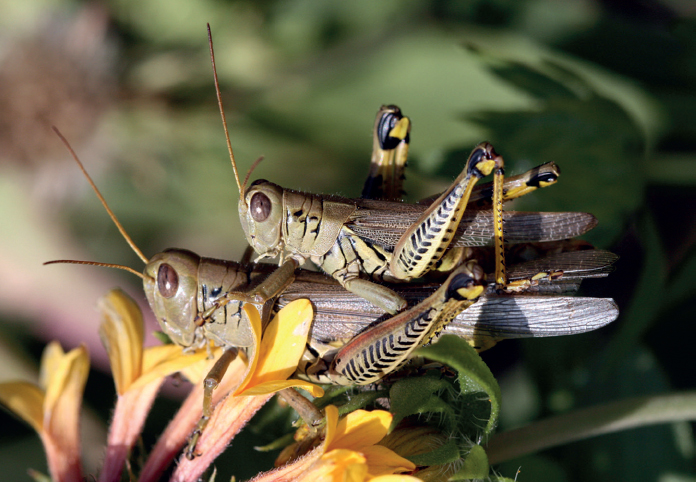
B. Pair of differential grasshoppers. WHITNEY CRANSHAW

C. Migratory grasshopper. SCOTT SCHELL, UNIVERSITY OF WYOMING

D. Redlegged grasshopper. JIM KALISCH, UNIVERSITY OF NEBRASKA
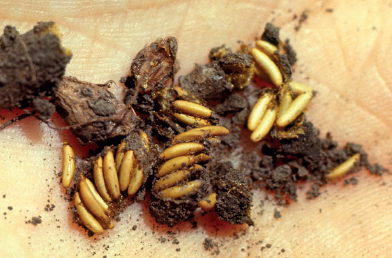
E. Grasshopper egg pod. DAVID L. KEITH, UNIVERSITY OF NEBRASKA

F. Clearwinged grasshopper. WHITNEY CRANSHAW

G. Devastating grasshopper. JACK KELLY CLARK, COURTESY OF UNIVERSITY OF CALIFORNIA STATEWIDE IPM PROGRAM.

H. Grasshopper laying eggs. COLORADO STATE UNIVERSITY ARCHIVES.
Grasshoppers can show migratory behaviors. Nymphs sometimes march considerable distances in bands during outbreaks. Adults are capable of flight and may fly for several miles, often at elevations of several hundred feet above the ground. Modest physical changes may sometimes occur in populations that become more migratory. For example, thinner body size and longer wings are produced by twostriped and migratory grasshoppers that go into the more migratory phase.
Although grasshoppers in the genus Melanoplus are usually the species involved in damage to garden plants, there are some other species that can be regionally damaging or attract attention.
CLEARWINGED GRASSHOPPER (Camnula pellucida)1 has had several historical outbreaks in the Rocky Mountain/High Plains region. It is a fairly common species, found in most of North America except the southeastern states. Adults are medium-sized and yellow to brown with mottled forewings and transparent hindwings. Grasses are favored, and the species can be a severe pest of small grains, but it occasionally damages onions, lettuce, cabbage, and peas in gardens. Clearwinged grasshopper eggs hatch quite early in the season, following a few warm days in early spring, and most eggs hatch over a brief period. During the summer, when eggs are being laid, the females alternately move from feeding sites in fields to egg-laying beds where soil conditions are favorable.
VALLEY GRASSHOPPER (Oedaleonotus enigma)1 is found in semiarid areas of western North America, and is most commonly noted to be damaging in California. Eggs hatch in spring, often in early April in California, and they feed primarily on broadleaf plants, including shrubs. Both long-winged and short-winged (brachypterous) adult forms may be produced, with high temperatures favoring the latter.
CAROLINA GRASSHOPPER (Dissosteira carolina)1 is a common, large grasshopper sometimes seen hovering over areas of bare ground. The hindwings, exposed in flight, are colorfully marked with black and have a yellow border; however, the overall color of the grasshopper, and of the covering forewings, is tannish to gray brown. Carolina grasshopper feeds on a wide variety of plants but is rarely abundant enough to cause serious damage.
EASTERN LUBBER GRASSHOPPER (Romalea guttata)2 is the largest grasshopper found in North America. Heavy-bodied and reaching a length of 2 to almost 3 inches, it is a colorful insect of variable patterning, primarily black in young stages with more yellow and orange in the adults. The short, nonfunctioning wings are pinkish or reddish. Eastern lubber is found in the southeastern states, from South Carolina to east Texas. It is most abundant in slightly moist habitats where it feeds on a wide range of weedy plants, but it does occasionally invade vegetable and flower gardens. Eggs hatch in March and April. In much of the High Plains and southern Rocky Mountain region, the PLAINS LUBBER (Brachystola magna)2 is present and rivals eastern lubber in size. It feeds primarily on wild sunflower, kochia, hoary vervain, and other rangeland plants, rarely damaging cultivated plants. This species is usually green to brown and also has short wings.
1 Orthoptera: Acrididae
2 Orthoptera: Romaleidae

B. Eastern lubber grasshoppers feeding on crinum lilies. DOUG CALDWELL, UNIVERSITY OF FLORIDA

C. Eastern lubber grasshopper. DAVID SHETLAR

D. Pair of plains lubber grasshoppers. WHITNEY CRANSHAW
FIELD CRICKETS (Gryllus spp.)1
DAMAGE Field crickets eat a wide variety of plant materials. Although rarely damaging to garden plants, they are occasionally associated with injury to seedlings of many plants, including tomatoes and beans. Field crickets are also one of the insects most commonly associated with damage to irrigation tubing. Occasionally field crickets will incidentally enter homes, where their persistent chirping may be considered annoying; chewing damage to fabrics by field cricket has also been reported.
DISTRIBUTION Field crickets are found throughout North America, with 16 species. It is difficult to distinguish most species by physical features; some often separated only by aspects of behavior, including their life cycle and the male’s song. FALL FIELD CRICKET G. pennsylvanicus)1 and SPRING FIELD CRICKET (G. veletis) tend to predominate in most of North America. SOUTHEASTERN FIELD CRICKET (G. rubens), also known as the “eastern trilling cricket,” is restricted to the southeastern states. It is physically identical to TEXAS FIELD CRICKET (G. texensis) which occurs in Texas, Oklahoma, and southern states, sometimes in spectacular swarms attracted to lights.
APPEARANCE Field crickets are predominantly black, often shiny, but may have some brown on the front wing. When fully grown they are about ¾ inch long. Males and females can be easily separated by the presence or absence of the prominent ovipositor, used by the females to lay eggs. Field crickets are also well known among the “singing” insects, producing the familiar trilling chirping noises of the night. Only the males sing, which they do by rubbing special ridged structures (file, scraper) along the edge of the wings. Different songs are used to attract mates, during courtship, and to defend territories from other males.
LIFE HISTORY AND HABITS Field crickets are active at ground level, usually resting under sheltering debris during the day and active at night. Overwintering stages may vary; fall field cricket spends winter as eggs in soil, spring field cricket as nearly full-grown nymphs. Eggs are laid in small groups in slightly damp soil. After egg hatch, nymphs take 2–3 months to develop, during which time they molt eight or nine times. Most field crickets have a single generation per year, but the southeastern and the Texas field cricket have two.
OTHER CRICKETS AND KATYDIDS
The ROBUST GROUND CRICKETS (Allonemobius spp.)1 are a complex of six closely related species distinguishable largely by differences in song, habitat, and minor morphological features. All are varying shades of brown and can be distinguished from field crickets by having long spurs on the hind leg. They are most abundant in grassy areas, including turfgrass areas. Robust field crickets are omnivorous, feeding on dead plant material and fungi, but mostly various low-growing plants, with legumes such as clover and alfalfa preferred. The STRIPED GROUND CRICKET (A. fasciatus) has the widest range, occurring over much of eastern North America, into Canada and the Pacific Northwest. The SOUTHERN GROUND CRICKET (A. socius) is often the most common species in southern states. These crickets can be common in and around yards and fields, but they rarely damage garden plants. Most species have a one-year life cycle and overwinter in the egg stage; the southern ground cricket can have two generations.
TREE CRICKETS (Oecanthus spp.)1 are similar in length to field crickets but more slender-bodied and occur on aboveground areas of plants. Typical species are green or yellow-green; some have dark markings and black appendages. They are most commonly associated with trees and shrubs, particularly tree fruits and caneberries. All have one generation per year, with winter spent in the egg stage.

B. Female field cricket. DAVID SHETLAR

C. Male field cricket. WHITNEY CRANSHAW

D. Field cricket, late-instar nymph. WHITNEY CRANSHAW
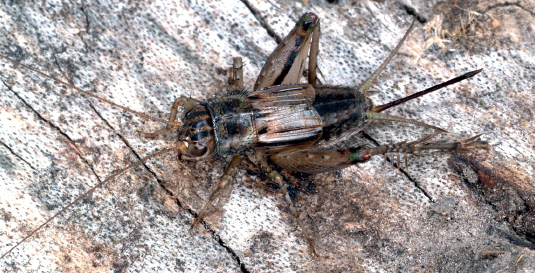
E. Striped ground cricket, female. JIM KALISCH, UNIVERSITY OF NEBRASKA

F. Striped ground cricket, male. JIM KALISCH, UNIVERSITY OF NEBRASKA

G. Blackhorned tree cricket, female. DAVID CAPPAERT

H. Blackhorned tree cricket, male. DAVID CAPPAERT

I. Tree cricket at egg hatch. KEN GRAY COLLECTION, OREGON STATE UNIVERSITY

J. Tree cricket oviposition wounds in twig. WHITNEY CRANSHAW
Although tree crickets may feed on leaves, they do little damage. Plants are injured primarily during late summer when eggs are laid. Females insert eggs into stems and canes, which may result in rough calloused areas around the wound, increase susceptibility to stem breakage, and allow entry of canker-producing fungi into the plant. One of the common species one may find is the BLACKHORNED TREE CRICKET (O. nigricornis), easily distinguished because adults usually have black legs and dark markings on the head and pronotum. The TWOSPOTTED TREE CRICKET (Neoxabea bipunctata) is very common and is distinctive because of the tan color with two darker spots on the upper surface of the folded wings. NARROWWINGED TREE CRICKET (O. niveus) is another common species.
The SNOWY TREE CRICKET (O. fultoni)1 is a pale green species that occurs over a broad area of the northern U.S. and parts of southern Canada. It is particularly well known because it has been shown that it can be used to determine temperature, as a type of living thermometer., based on its rate of chirping, which varies reliably with temperature in a manner that has been quantified. The formula for determining temperature by chirping rate is known as Dolbear’s Law, after A. E. Dolbear, who first published on the phenomenon in 1897. The formula is T = 40 + N15, where T is temperature (in Fahrenheit) and N is the number of chirps in 15 seconds.
KATYDIDS2 are substantially larger than tree crickets and have a general resemblance to grasshoppers but have much longer antennae and thin jumping hind legs. Most are green, which allows them to blend in well with the foliage of trees and shrubs on which they feed. Both the nymphs and adults chew leaves, rarely causing noticeable injuries. Most katydids lay their flattened eggs along twigs and these can resemble a double row of fish scales.
Katydids are far more commonly heard than seen as the males make calls during evening and night to attract mates. These sounds are produced by stridulation, in a manner similar to crickets, by rubbing special structures of the forewings (the “file” and “scraper”). Perhaps best known is the song of the TRUE KATYDID (Pterophylla camellifolia),2 a loud rasping “katy-did” call. This insect is widely distributed east of the Rocky Mountains, with substantial regional variation in the types of calls it produces. Clicking calls are characteristic of the BROADWINGED KATYDID (Microcentrum rhombifolium),2 also known as the GREATER ANGLE-WING KATYDID, a species that can be found across the U.S. and in parts of southern Canada; the related LESSER ANGLE-WING KATYDID, M. retinerve, is restricted to eastern North America. BUSH KATYDIDS (Scudderia spp.),2 marked by narrower wings, produce various rattling calls. Bush katydids tend to be more commonly encountered in the southern U.S. in gardens where perennials, grasses, and shrubs are used. These have very brightly colored nymphs that draw attention.
CAMEL CRICKETS3 are wingless crickets that possess very long antennae and have a characteristically humped body in profile. Several dozen Ceuthophilus species are native to North America, with some found in very restricted environments, notably caves. Several species can be common in and around yards and gardens—and sometimes within buildings, where they are usually found in more humid areas of the structure. Camel crickets feed at night and have very omnivorous food habits, consuming fungi, dead plant matter, carrion, and dead insects. Living plants are rarely damaged.
An introduced species known as the GREENHOUSE CAMEL CRICKET (Diestrammena asynamora)3 has become widely established in much of eastern North America, and in many areas it is now the most common camel cricket found outdoors and within buildings. This species more often damages living plants and is a particular pest threat within greenhouses.
1 Orthoptera: Gryllidae
2 Orthoptera: Tettigoniidae
3 Orthoptera: Rhaphidophoridae

B. Snowy tree cricket, male. DAVID SHETLAR

C. “True” katydid. HERBERT A. “JOE” PASE III, TEXAS A&M FOREST SERVICE, BUGWOOD.ORG

D. Broadwinged katydid. WHITNEY CRANSHAW

E. Eggs of the broadwinged katydid. WHITNEY CRANSHAW

F. Broadwinged katydid nymph. WHITNEY CRANSHAW

G. Bush katydid, Scudderia sp. WHITNEY CRANSHAW

H. Greenhouse camel cricket. JIM KALISCH, UNIVERSITY OF NEBRASKA

I. Camel cricket. DAVID SHETLAR
COMMON (NORTHERN) WALKINGSTICK (Diapheromera femorata)1
HOSTS Oak, black cherry, elm, basswood, and black locust are favored plants. Paper birch, aspen, dogwood, and hickory are occasional hosts.
DAMAGE Nymphs and adults chew leaves. Damage is usually minor, but occasional outbreaks in forests cause significant defoliation.
DISTRIBUTION Over much of the area east of the Great Plains except the most southern states. It is most numerous around the Great Lakes.
APPEARANCE Full-grown adults reach a length of about 3 inches. They are highly variable in color and may be nearly pure green, gray, brown, or mottled.
LIFE HISTORY AND HABITS Eggs of the common walkingstick hatch in late spring from eggs resting on soil. In forests the young nymphs usually feed first on the leaves of low-growing plants, then move to trees as they get older. Adults are present by midsummer, and the females drop their seedlike black eggs indiscriminately until frost. In southern areas of the range, these eggs usually hatch the following spring, but in the northern states and Canada they remain dormant until the second season.
RELATED SPECIES
There are 29 species of walkingsticks in North America, but most are rarely observed. TWOSTRIPED WALKINGSTICK (Anisomorpha buprestoides) is one of the larger North American species, with a body length of about 2½–3 inches, and is marked with 3 longitudinal black stripes. It is found in the Gulf States, where it feeds primarily on oak, although rose, crape myrtle, and other plants are also reported hosts. For defense it can discharge a directed squirt, over a distance of 12 inches or more, of a strong smelling fluid that can be very irritating to eyes and mucous membranes. The NORTHERN TWOSTRIPED WALKINGSTICK, A. ferruginea, is a related, smaller species with more northern range. The most common species in the Great Plains and Rocky Mountains States is the PRAIRIE WALKINGSTICK (D. velii), which feeds on various prairie shrubs and grasses, notably big bluestem.
1 Phasmatodea: Heteronemiidae
A. Walkingstick. JAMES SOLOMON, USDA FOREST SERVICE, BUGWOOD.ORG

B. Walkingstick. DAVID CAPPAERT

C. Prairie walkingstick, mating pair. WHITNEY CRANSHAW

D. Mating pair of Anisomorpha sp. walkingsticks. HERBERT A. “JOE” PASE III, TEXAS A&M FOREST SERVICE, BUGWOOD.ORG
EUROPEAN EARWIG (Forficula auricularia)1
HOSTS European earwig is a true omnivore and feeds on a diet of insects and plant matter. Small, soft-bodied insects such as aphids and insect eggs are important protein sources; these are supplemented with soft plant matter from leaves and flower petals, especially during dry weather. European earwig can be particularly abundant on plants that also provide tight areas for daytime shelter, such as large flowers (e.g., rose, dahlia) and the ear tips of corn.
DAMAGE Adults and nymphs may feed on leaves, flower blossoms, and corn silks. Tender vegetable seedlings may be entirely consumed and soft, ripe fruits such as peaches and nectarines may be tunneled, the earwigs usually entering through the stem end. The habit of Euopean earwig to seek out tight, dark places to spend the day can make it an unwanted presence in many types of harvested fruits, vegetables, and flowers.
DISTRIBUTION As the name implies, European earwig is an introduced species. It has spread rapidly and is now found throughout almost all of North America with the exception of some southern states.
APPEARANCE Adults are approximately ¾ inch long with prominent pincers. The general color is reddish brown, often with bronze tones. Short, pale brown wing covers are present on the thorax. Males have long, bowed pinchers while those of females are fairly straight.
LIFE HISTORY AND HABITS European earwigs overwinter primarily as adult females. They become active on warm days in late winter, when the females dig small nests beneath rocks, within mulched areas of garden beds, or in other protected sites. A cluster of about 50 eggs is produced and then tended by the mother. After the eggs hatch, typically in late March or April, the mother continues to guard and care for the young earwigs for several weeks until they have molted and are ready to leave the nest. The young then disperse to forage on their own, becoming full grown in about 1 month. Often the mother lays a second, smaller egg mass in May or June. There is only one generation per year, but developing earwigs may be present throughout the growing season because of the double broods of overwintered females. Foraging occurs at night, with movement to dark, sheltered areas during the day. As the season progresses, the earwigs increasingly tend to aggregate in these shelter sites. Although the European earwig has wings, it very rarely, if ever, flies.
OTHER EARWIGS
RINGLEGGED EARWIG (Euborellia annulipes)2 is found primarily in warmer areas but is occasionally found throughout much of the continent. It is appears black with white bands on the legs and is wingless. Like the European earwig it has omnivorous food habits, doing some leaf chewing, but feeds primarily on other arthropods and is often an important biological control of some pest insects. Two generations are produced annually.
Three species of earwigs in the genus Doru1 occur in the southern U.S. They have wings and are marked with tan bands on the area behind the head (pronotum) and front wings. They are predators of caterpillars and other insects.
SHORE EARWIG (Labidura riparia)3 is the largest earwig found in the southern U.S. and Mexico, most commonly in coastal areas. It is also a predator but will occasionally throw up mounds of soil in gardens and low-cut turf. Adults can effectively apply a noticeable pinch with their cerci.
1 Dermaptera: Forficulidae
2 Dermaptera: Carcinophoridae
3 Dermaptera: Labiduridae

B. Female (top) and male (bottom) European earwigs. JIM KALISCH, UNIVERSITY OF NEBRASKA

C. European earwig female tending eggs. DAVID SHETLAR

D. Immature European earwig. WHITNEY CRANSHAW

E. European earwig feeding at night. WHITNEY CRANSHAW

F. Ringlegged earwig. DAVID SHETLAR

G. Doru sp. earwig. RUSS OTTENS, UNIVERSITY OF GEORGIA, BUGWOOD.ORG

H. Shore earwig. DAVID SHETLAR
Cockroaches are primarily tropical insects, with only about 50 species present in North America, and many are introduced species. Often these introduced species have limited distribution within the region, and some are essentially restricted to living within buildings, including most of the more notorious commensal species that can be serious household pests. Notable household pest cockroaches include the GERMAN COCKROACH (Blattella germanica),1 BROWNBANDED COCKROACH (Supella longipalpa),1 AMERICAN COCKROACH (Periplaneta americana),2 SMOKYBROWN COCKROACH (Periplaneta fulginosa),2 and ORIENTAL COCKROACH (Blatta orientalis).2
Outdoors, cockroaches are usually found under fallen leaves, among woodpiles, under wood shingles, around compost piles, and in other sheltered sites during the day. They forage for food at night, and most cockroaches are omnivores that feed on a wide variety of foods, with decaying plant matter usually making up most of the diet; however, a few species do feed on living plants, particularly soft seedlings, and can be plant pests.
One cockroach that has been reported to cause serious injury to seedling plants in greenhouses is the AUSTRALIAN COCKROACH (Periplaneta australasiae). It closely resembles the American cockroach but is slightly smaller and has the edges of the thorax bordered in yellow. Also common in greenhouses and in atrium plantings can be the SURINAM COCKROACH (Pycnoscelus surinamensis),3 a type of burrowing cockroach that can easily tunnel into the soil and mulch around plants. At night they emerge and may chew on soft parts of plants.
In Hawaii the PACIFIC BEETLE COCKROACH (Diploptera punctata)3 chews on the bark of cypress and juniper, sometimes causing serious damage. MADEIRA COCKROACH (Rhyparobia maderae)3 is a pest of soft fruits (banana, grapes) in tropical areas; it has been periodically introduced on produce, but has been found only in localized areas and is not well established in North America. The GREEN BANANA COCKROACH (Panchlora nivea),3 also known as the “Cuban cockroach,” is another non-native species now well established in the Gulf States. It is a very attractive green color and not considered a pest species, limiting its feeding to dead and decaying plant matter.
A non-native cockroach that may cause more nuanced effects in gardens is the ASIAN COCKROACH (Blattella asahinai). Now well established in much of the southern/southeastern parts of the U.S., it has been shown to be an important predator of insects, notably feeding on eggs of caterpillars. This cockroach is very similar in appearance to the German cockroach, but it differs in habits by rarely entering buildings and is normally found outdoors among fallen leaves and similar debris. The Asian cockroach can also readily fly, unlike its more human-adapted relative, the German cockroach.
The cockroaches that are native to the U.S. are best represented by various WOODS COCKROACHES (Parcoblatta spp.).1 About a dozen species can be found scattered across much of the U.S., inhabiting wooded areas and feeding on decaying plant matter. Adults typically reach a length of ¾ to 1 inch. Females are a bit smaller than males, and their wings do not extend to fully cover the abdomen. Males have fully developed wings. Only rarely do they enter buildings, but males are good fliers and are often attracted to outdoor lights.
1 Blattodea: Ectobiidae
2 Blattodea: Blattidae
3 Blattodea: Blaberidae

B. German cockroach. DAVID SHETLAR

C. Oriental cockroach, various life stages. JIM KALISCH, UNIVERSITY OF NEBRASKA

D. Australian cockroach, various life stages. JIM KALISCH, UNIVERSITY OF NEBRASKA

E. Surinam cockroach. DAVID SHETLAR

F. Green banana cockroach, Panchlora nivea. DAVID SHETLAR

G. Asian cockroach, nymph. JOHNNY N. DELL, BUGWOOD.ORG

H. Pennsylvania wood roach. JIM KALISCH, UNIVERSITY OF NEBRASKA

I. Woods cockroach, Parcoblatta virginica. WHITNEY CRANSHAW
IMPORTED CABBAGEWORM (Pieris rapae)1
HOSTS Essentially all cultivated mustard family plants, including cabbage, broccoli, kale, Brussels sprouts, and collards. Many cruciferous weeds are also important host plants.
DAMAGE Larvae chew foliage. Most early feeding occurs on outer leaves, but older larvae tend to feed more intensively on the newer growth and can seriously tunnel the heads of many plants.
DISTRIBUTION Common throughout North America.
APPEARANCE The caterpillars are rather sluggish, velvety green with 5 pairs of distinct prolegs. A faint yellow line runs along the back of older larvae. The adult, often known as the CABBAGE WHITE, has upper wings that are predominantly white, with a slightly dark tip of the forewing. Males have a single black spot on the forewing, whereas females have two such spots. The underside of the wings is yellowish.
LIFE HISTORY AND HABITS In the northern U.S. and Canada, imported cabbageworms spend winter as pupae among plant debris in the vicinity of previously infested plants. The adults are one of the first butterflies to emerge in spring. After a period of mating and egg maturation, females begin to lay their yellow, bullet-shaped eggs on leaves. The eggs are laid singly, often on the underside of the leaf as the female perches on the leaf edge, and eggs may be produced over the course of about three weeks.
Larvae hatch in 3–5 days and begin to feed on plants, often first remaining on the outer leaves. Later they tunnel into the head. Larvae are full grown in 2–3 weeks. Pupation occurs in the vicinity of the plant. Two to four generations are typically completed in much of the northern area of the range. In the southern U.S., however, breeding can be continual and as many as six to eight generations may occur.
OTHER SULFUR AND WHITE BUTTERFLIES
SOUTHERN CABBAGEWORM (Pontia protodice)1 is found primarily in the southern U.S. but may disperse northward into the Prairie Provinces. Larvae are much more brightly colored than imported cabbageworm, with black spotting and yellow striping. Feeding habits are similar to those of imported cabbageworm, but southern cabbageworm tends to feed more often on buds and flowers. The adult stage is known as the CHECKERED WHITE BUTTERFLY and possesses dark spotting on its white wings. The GREAT SOUTHERN WHITE (Ascia monuste) is a nearly pure white species that is considerably larger than the cabbage butterfly, and larvae may occasionally be found feeding on radish, cabbage, and other Brassicaceae. It is a southern species, most often found in the Gulf States, and ranges into South America. On occasion it may stray into northern areas as far north as Maryland and Colorado.

Imported cabbageworm damage to broccoli. WHITNEY CRANSHAW
ALFALFA CATERPILLAR (Colias eurytheme)1 feeds on legumes, including pea, most clovers, alfalfa, and bean. The caterpillars are dark green with a light line running along each side. Adults are orange-yellow butterflies that sometimes become abundant where alfalfa is grown. Closely related and of similar habit is CLOUDED SULFUR (C. philodice).
1 Lepidoptera: Pieridae
A. Egg of the imported cabbageworm. DAVID CAPPAERT, BUGWOOD.ORG

B. Imported cabbageworm at egg hatch. DAVID CAPPAERT, BUGWOOD.ORG

C. Late-instar larvae of imported cabbageworm. WHITNEY CRANSHAW

D. Adult of the imported cabbageworm, the cabbage white. DAVID CAPPAERT, BUGWOOD.ORG

E. Mating pair of cabbage white butterflies. DAVID SHETLAR

F. Chrysalis of imported cabbageworm. RUSS OTTENS, UNIVERSITY OF GEORGIA, BUGWOOD.ORG

G. Larva of the checkered white, the southern cabbageworm. WHITNEY CRANSHAW

H. Checkered white butterfly. WHITNEY CRANSHAW

I. Larva of the great southern white, Ascia monuste. ALTON J. SPARKS JR., UNIVERSITY OF GEORGIA, BUGWOOD.ORG

J. Alfalfa caterpillar. JOHN CAPINERA, UNIVERSITY OF FLORIDA

K. Recently emerged adult of the alfalfa caterpillar, next to its chrysalis. KEN GRAY COLLECTION, OREGON STATE UNIVERSITY

L. Clouded sulfur. DAVID CAPPAERT, BUGWOOD.ORG
Swallowtails include some of the largest and most striking butterflies found in North America, a welcome addition to most any garden. The caterpillar stages feed on leaves and are also of unusual and interesting appearance, with many having bright warning coloration or large eyespot markings, or are of cryptic appearance resembling bird droppings. Larvae also have the unique habit of being able to extend forked fleshy scent glands (osmeteria) from behind the head when disturbed. These glands also secrete odors that may be distasteful to potential predators.
PARSLEYWORM/BLACK SWALLOWTAIL (Papilio polyxenes)1
HOSTS Dill, parsley, and fennel are common hosts. The caterpillars may also be found on carrot, Queen Anne’s lace, celery, caraway, and other plants in the family Apiaceae. Common rue (Ruta graveolens) is also an occasional host.
DAMAGE The caterpillars develop primarily by chewing on leaves. When flowering structures are present they may clip flower heads and feed on developing seeds.
DISTRIBUTION Primarily east of the Rockies, although occasionally found in southern California and Arizona.
APPEARANCE Adults are known as black swallowtails, large butterflies with a wingspan of 2¼ to 3¼ inches. The primary coloration is shiny black, sometimes with iridescent blue, marked with yellow bands or spots along the edge of the wings.
Young caterpillars, known as parsleyworms, are mottled black and white, resembling bird droppings. Later instars dramatically transform to possess prominent banding of yellow, white, and black. When disturbed they will usually extend a yellow-orange scent gland (osmeterium) from behind the front of the head. LIFE HISTORY AND HABITS Parsleyworm spends the winter as a pupa (chrysalis) attached to tree bark, rocks, the sides of buildings, or other protected locations. Adults typically emerge in late May and early June. After mating females will lay eggs over a period of several weeks, laying a series of individual eggs, usually on younger leaves or flowers of their host plants. Males establish territories they will regularly patrol, waiting for receptive females to pass and chasing away males.
Eggs hatch 4–9 days after being laid and the caterpillars feed for about 3–4 weeks, undergoing a series of color changes and patterning as they get older. When full grown, they wander away from the host plant to find a protected spot where they will transform to the pupal stage. The pupa is in the form of a greenish or grayish-brown chrysalis, the colors matching the background to which it is attached. There are typically two generations produced per year in northern areas and three in southern areas. In the early season generations, the adult butterflies emerge from the chrysalis in about two weeks following pupation. In the last generation, the insect remains dormant within the chrysalis and emerges the following year.

B. Parsleyworm with osmeteria everted. SUSAN ELLIS, BUGWOOD.ORG

C. Egg of the parsleyworm/black swallowtail. DAVID SHETLAR

D. Early-instar parsleyworm larva. DAVID SHETLAR

E. Middle-instar parsleyworm larva. JIM KALISCH, UNIVERSITY OF NEBRASKA

F. Chrysalis of the parsleyworm/black swallowtail. WHITNEY CRANSHAW

G. Parsleyworm preparing to pupate (prepupa). DAVID SHETLAR

H. Black swallowtail, female. JOHN CAPINERA
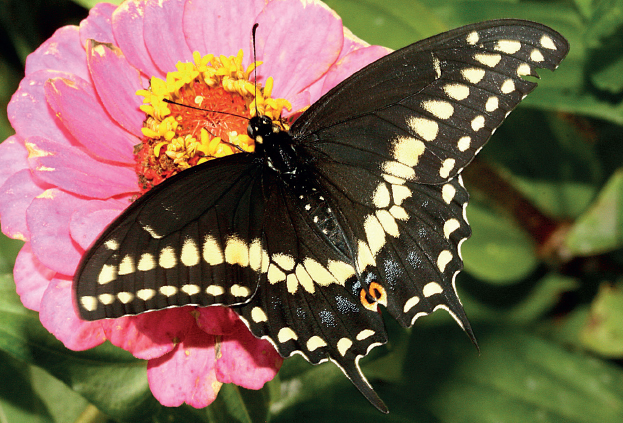
I. Black swallowtail, male. DAVID SHETLAR
The closely related ANISE SWALLOWTAIL (Papilio zelicaon) develops on fennel and some plants in the citrus family (Rutaceae). It is found primarily west of the Continental Divide, including the southwestern U.S., and its larvae are sometimes known as the CALIFORNIA ORANGEDOG. SHORT-TAILED SWALLOWTAIL (P. brevicauda) occurs in eastern Canada and occasionally damages the foliage of parsnip.
TIGER SWALLOWTAILS are large yellow and black butterflies. In western North America two common species are TWO-TAILED SWALLOWTAIL (Papilio multicaudatus), developing primarily on chokecherry and ash, and WESTERN TIGER SWALLOWTAIL (P. rutulus), associated with willow, cottonwood, and chokecherry. In eastern North America EASTERN TIGER SWALLOWTAIL (P. glaucus) develops on the foliage of various trees, including wild cherry, sweetbay, basswood, tuliptree, birch, ash, cottonwood, mountain-ash, and willow. Young tiger swallowtail caterpillars are mottled black and white and resemble bird droppings. Older caterpillars may be brown or lime green with prominent eyespots. When sufficiently disturbed, these larvae rear up and extrude their forked yellow scent glands, producing an appearance of a rearing snake.
GIANT SWALLOWTAIL (P. cresphontes) is common in much of the southwestern and southeastern U.S., commonly migrating northward. Caterpillars develop on citrus, and the conspicuous caterpillars are sometimes known as orangedogs.

Egg of a two-tailed swallowtail. WHITNEY CRANSHAW

Late-instar larva, brown form, of the two-tailed swallowtail. WHITNEY CRANSHAW
1 Lepidoptera: Papilionidae

A. Eastern tiger swallowtail. HERBERT A. “JOE” E. PASE III, TEXAS A&M FOREST SERVICE, BUGWOOD.ORG
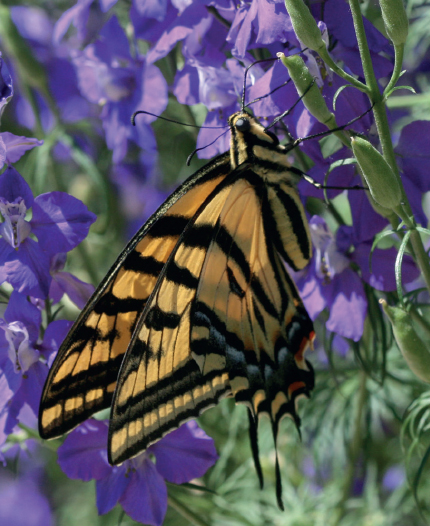
B. Two-tailed swallowtail. WHITNEY CRANSHAW

C. Early-instar larva of the two-tailed swallowtail. WHITNEY CRANSHAW

D. Giant swallowtail. DAVID SHETLAR

E. Late-instar larva, green form, of the two-tailed swallowtail, everting osmeterium. JOHN CAPINERA, UNIVERSITY OF FLORIDA

F. Orangedog, larva of the giant swallowtail. DAVID SHETLAR
Brushfooted butterflies (Nymphalidae family) are a common group of moderately large butterflies. The upper surfaces of the wings are often brightly colored, but the lower surfaces may be more camouflaged. The front pair of legs is greatly reduced. Although many brush-footed butterflies feed at flowers, others visit sap flows, fermenting fruit, and animal dung. Few species ever seriously damage plants in the caterpillar stage.
PAINTED LADY/THISTLE CATERPILLAR (Vanessa cardui)1
HOSTS A wide range of plants, with more than 100 species from several plant families reported. Common hosts include Canada thistle, other thistles, sunflower, Jerusalem artichoke, hollyhock, common mallow, and lupine.
DAMAGE Caterpillars chew foliage, sometimes causing significant defoliation.
DISTRIBUTION Painted lady is one of the most widely distributed butterflies in the world, found on almost every continent. It occurs throughout the U.S. and southern Canada as either a winter resident or seasonal migrant.
APPEARANCE The caterpillar stage, known as thistle caterpillar, is generally black with some lighter flecking and numerous fleshy dark spines. It is almost always associated with a loose silken shelter it constructs among leaves. The adult stage of the insect is known as painted lady. It is generally orange with irregular black and white spotting on the wings.
LIFE HISTORY AND HABITS Painted lady is an annual migrant in much of North America, spending the winter in more southerly areas, including Mexico. In spring, migrations are northward; in fall, to the south. Females lay eggs singly on host plants. Caterpillars produce a shelter of loose webbing by tying leaves together. When abundant, they extensively defoliate plants, and once the food plant is destroyed, the caterpillars migrate. Pupation occurs in a silvery chrysalis, usually some distance from the food plant. Adults emerge about one week after pupation and usually disperse from the area. Several overlapping generations are produced annually, with returning southward migrations observed in late summer.
OTHER BRUSHFOOTED BUTTERFLIES
Three other Vanessa species of butterflies occur commonly over much of North America. The RED ADMIRAL (Vanessa atalanta) is the most distinctively different in appearance, with upper wings having large dark areas and edged with orange stripes and white spots. It can be found throughout the U.S. and southern Canada. Three generations are normally produced in the southern areas, two in much of its North American range, and one generation in the north, where it may not regularly survive winters. Seasonal differences in appearance, with butterflies produced during summer being larger and brighter than those produced in winter. The red admiral is most commonly observed in moist sites, such as near streams, and along edges of woodland. The larvae feed on stinging nettles (Urtica spp.) and false nettle (Boehmeria cylindrica).

B. Chrysalis of the painted lady. WHITNEY CRANSHAW

C. Painted lady, side view. JIM KALISCH, UNIVERSITY OF NEBRASKA

D. Painted lady larva in thistle. JIM KALISCH, UNIVERSITY OF NEBRASKA

E. Larva of the red admiral. DAVID SHETLAR

F. Red admiral. DAVID SHETLAR
The AMERICAN LADY (V. virginiensis) also has a wide distribution that can include much of North America, although it is most common east of the Mississippi. The range of plants used as larval foods is considerably narrower than that of the painted lady, with everlasting types of composites (e.g., pearly everlasting, sweet everlasting, plantain-leaved pussytoes) being the most common hosts. Three or four generations are produced in the southern U.S., although reproduction may be temporarily suspended during midwinter. Survival through winter in areas with freezing winters is unlikely, and the presence of American lady in these areas results from annual migrations from the south. The WEST COAST LADY (V. annabella) has the most restricted distribution, occurring only in western North America. Larvae develop on nettles and various mallows, including hollyhock.
The MONARCH (Danaus plexippus) is one of the most familiar of the North American butterflies, both large in size and brightly patterned with orange and black. The larvae develop on various milkweeds (Asclepias), are colorfully striped with white, black and yellow, and have two pairs of filaments: a pair arising from the thorax and a pair from the tip of the abdomen. Garden plants that commonly support monarch caterpillars include A. tuberosa (butterfly milkweed), A. syriaca (common milkweed), A. incarnata (swamp milkweed), and A. curassavica (tropical milkweed or bloodflower). All these plants contain compounds (cardiac glycosides) that are toxic to mammals and birds, and both the adult and larval stages store these in their body for defense.
The monarch is a migratory species that spends part of the winter in a temporarily dormant state at specific sites where they aggregate. Populations that occur in areas east of the Rocky Mountains migrate to Mexico in autumn and aggregate in forested areas in mountains east of Mexico City. Populations that develop in the Pacific States produce winter aggregations in several different sites of pine forest. Most of these western overwintering aggregation sites are in California, but some monarchs move into western Mexico. The overwintered butterflies resume activity in early spring, laying eggs on newly available host plants on which a new generation develops. Adults of these then disperse northward, where they extensively colonize much of the U.S. and southern Canada.
Also developing on milkweeds is the QUEEN (Danaus gilippus). This is a subtropical and tropical species that can breed year-round in the extreme southern areas of Texas and Florida. Elsewhere it occurs as an incidental summer migrant. The larvae are also brightly patterned but have some bluish coloration and 3 pairs of black filaments, which can distinguish them from monarch caterpillars.
Of remarkably similar appearance to the monarch is the adult of the VICEROY (Limenitis archippus). Larvae of this butterfly develop mostly on willow, and they are generally found throughout North America, particularly in moist sites that support their host plants. The caterpillars and the pupae resemble bird droppings.
A. American lady. JOHNNY N. DELL, BUGWOOD.ORG

B. Larva of the American lady. JIM KALISCH, UNIVERSITY OF NEBRASKA

C. Western lady. TERRY SPIVERY, USDA-FS, BUGWOOD.ORG

D. Monarch. DAVID SHETLAR

E. Larva of the monarch butterfly. JIM KALISCH, UNIVERSITY OF NEBRASKA

F. Chrysalis of the monarch butterfly. DAVID SHETLAR
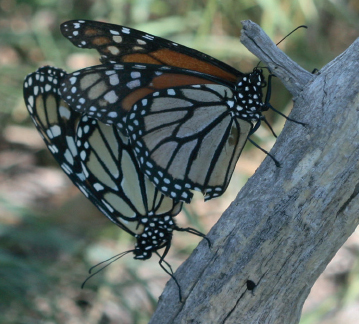
G. Mating pair of monarch butterflies. WHITNEY CRANSHAW

H. Comparison of monarch (left) and viceroy (right) butterflies. WHITNEY CRANSHAW

I. Larva of the viceroy. HOWARD ENSIGN EVANS

J. Chrysalis of the viceroy butterfly. JIM KALISCH, UNIVERSITY OF NEBRASKA
MOURNING CLOAK (Nymphalis antiopa) is a dark purple-black butterfly with a yellowish border on the wing. It is one of the few butterflies that winters in the adult stage and may be observed flying about during warm spells in midwinter. Eggs are laid in spring in masses on aspen, cottonwood, poplar, willow, birch, elm, or hackberry. Larvae, known as SPINY ELM CATERPILLARS, are generally dark colored with purple markings and feed as a group during early instars. Often entire branches are stripped by larval feeding. When full-grown the caterpillars pupate, and the adults that subsequently emerge remain in a reproductively dormant state for the rest of the year. Adults butterflies may periodically feed at flowers, at sap flows, and on rotting fruit through summer and fall, but only a single generation is produced each year.
VARIEGATED FRITILLARY (Euptoieta claudia) produces brightly colored larvae covered with fleshy spines. They feed on pansy, violet, Johnny-jump-up, wild flax, and occasionally sedum, Passiflora, alyssum, and purslane. This species can be common and damaging to gardens and is sometimes known as “pansyworm.” It is primarily a southern species, overwintering as a full-grown larva, but it frequently strays into northern states during summer.

Larva of the variegated fritillary. WHITNEY CRANSHAW
HACKBERRY BUTTERFLY (Asterocampa celtis) and TAWNY EMPEROR (A. clyton) are associated with hackberry and sugarberry throughout the range of these plants. QUESTION-MARK (Polygonia interrogationis) develops on succulent foliage of elm, basswood, and hackberry in the eastern states. Larvae of the COMMON BUCKEYE (Junonia coenia) feed on plantains, snapdragon, and toadflax. GORGONE CHECKERSPOT (Chlosyne gorgone) develops on sunflowers and Lysimachia.
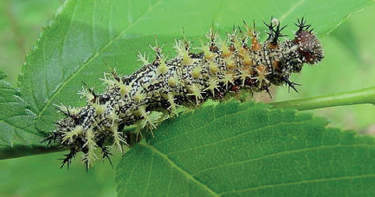
Larva of the question mark butterfly. HERBERT A. “JOE” PASS III, TEXAS A&M FOREST SERVICE, BUGWOOD.ORG

Larva of the hackberry butterfly. WHITNEY CRANSHAW
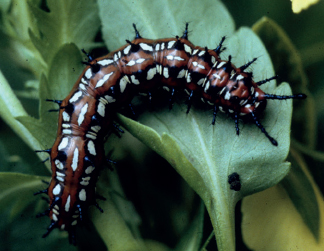
Larvae of the Gorgone checkerspot. JIM KALISCH, UNIVERSITY OF NEBRASKA
1 Lepidoptera: Nymphalidae

B. Larva of the mourning cloak, the spiny elm caterpillar. STEVEN KATOVICH, USDA-FOREST SERVICE, BUGWOOD.ORG

C. Variegated fritillary. WHITNEY CRANSHAW

D. Question mark butterfly. HERBERT A. “JOE” PASS III, TEXAS A&M FOREST SERVICE, BUGWOOD.ORG

E. Adult hackberry butterfly feeding on fluids from a dead raccoon. WHITNEY CRANSHAW
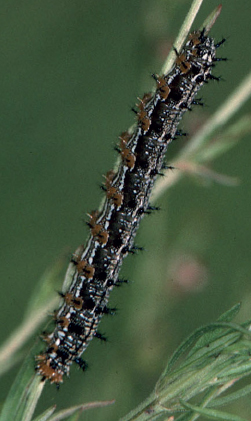
F. Larva of the common buckeye butterfly. JERRY A. PAYNE, USDA-ARS, BUGWOOD.ORG

G. Common buckeye butterfly. DAVID SHETLAR

H. Gorgone checkerspot. WHITNEY CRANSHAW
Hornworms (Sphingidae family) are among the largest caterpillars found in North America. All are marked by having, at least in the first stages, a prominent “horn” on the hind end. More than 120 species occur on the continent, but only a very few (e.g., tobacco hornworm, tomato hornworm, catalpa sphinx) become sufficiently abundant to regularly cause damage to plants. The majority develop on shade trees and shrubs, where damage is rarely noticed.
Adults are strong-flying, heavy-bodied moths known as sphinx moths or hawk moths. The moths feed on nectar from deep-lobed flowers. Those that are active during the day are sometimes known as “hummingbird moths.”
TOMATO HORNWORM/FIVESPOTTED HAWK MOTH (Manduca quinquemaculata)1
TOBACCO HORNWORM/CAROLINA SPHINX (Manduca sexta)1
HOSTS Tomato and tobacco are particularly susceptible to injury. Pepper, potato, and certain nightshade family weeds are also hosts.
DAMAGE Caterpillars chew leaves and can defoliate plants rapidly. Fruits, particularly green fruit, may also be chewed.
DISTRIBUTION Both species are found widely throughout the U.S. and southern Canada. Tobacco hornworm tends to predominate in southern areas and tomato hornworm in the north, but distributions overlap considerably.
APPEARANCE Larvae develop into large caterpillars, with five pairs of prolegs and a flexible “horn” on the last segment. Most are generally green. Seven diagonal white stripes are present along the side of the tobacco hornworm, and the horn is usually red. Tomato hornworm has a series of V-shaped white markings along the sides, and the horn is often black. Less common dark green or even black forms of tomato hornworm may be present. Adults of both are strong-flying, heavy-bodied moths. The forewings may have a span of up to 5 inches and are generally gray or grayish brown with light wavy markings.
LIFE HISTORY AND HABITS Tomato and tobacco hornworms spend the winter months in the pupal stage, within a chamber approximately 4–6 inches deep in the soil. Adult moths emerge in mid- to late spring and may migrate long distances. Eggs resemble small pearls and are laid singly on foliage. The newly hatched caterpillars possess a horn that is nearly the same length as the body and subsequently pass through four to five additional larval instars over the course of about a month. Full-grown larvae burrow several inches into soil and create a cell in which pupation occurs.
Where these insects can successfully survive winter conditions there are typically two generations produced annually. The adults are very strong fliers and in more northern areas, incidence of tomato and tobacco hornworms from year to year may be strongly influenced by migrations of moths originating from more southerly areas.

B. Egg of a tomato hornworm. DAVID SHETLAR

C. Tomato hornworm caterpillars showing different color morphs. JIM KALISCH, UNIVERSITY OF NEBRASKA

D. Adult of the tomato hornworm. DAVID SHETLAR

E. Tomato hornworm, young larva. DAVID SHETLAR
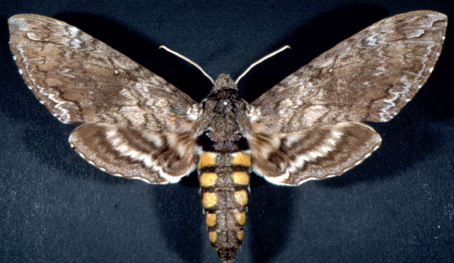
F. Adult of the tobacco hornworm. JOHN CAPINERA, UNIVERSITY OF FLORIDA

G. Tobacco hornworm. WHITNEY CRANSHAW

H. Pupa of a tobacco hornworm. JOHN CAPINERA, UNIVERSITY OF FLORIDA
WHITELINED SPHINX (Hyles lineata)1 is the most widely distributed sphinx moth in North America. It is particularly common throughout western North America, where it is familiar to gardeners as the most commonly encountered “hummingbird moth” and is marked with a prominent white band on the forewing. Larvae develop on a wide variety of plants, including portulaca, evening primrose, and grape. They can be highly variable in color, ranging from bright green to black. Two generations are produced annually, with overwintering occurring as a pupa in soil. Adults of GREAT ASH SPHINX (Sphinx chersis)1 are also commonly observed as day-flying hummingbird moths. Larvae of this species develop on ash, lilac, and privet.
Larvae of ACHEMON SPHINX (Eumorpha achemon)1 are unusual in that they lose the terminal horn during the last larval molt. Instead, the last-instar larva is marked by a prominent eyespot at the hind end. The caterpillars develop on Virginia creeper, grape, and related vines. Apparently there is one generation produced per year, with full-grown caterpillars most commonly observed in late August and early September. The achemon sphinx has broad distribution throughout most of the U.S. The closely related PANDORUS SPHINX (E. pandorus) has a more restricted distribution to the eastern half of North America, but similarly feeds on grape family plants. Also occurring on Virginia creeper and grape in the eastern U.S. is VIRGINIA CREEPER SPHINX (Darapsa myron).1

Full-grown caterpillar of the pandorus sphinx. HERBERT A. “JOE” PASE III, TEXAS A&M FOREST SERVICE, BUGWOOD.ORG
CATALPA SPHINX (Ceratomia catalpae)1 occurs throughout most of the eastern U.S., being particularly abundant in the southern states, where it may occur from Florida through parts of Texas. It develops on all species of catalpa and is sometimes abundant enough to defoliate trees, usually in August and September. Up to four generations may be produced annually in southern parts of the range. The caterpillars, sometimes known as “catawba worms,” are highly prized as fish bait in some locations. Related species include ELM SPHINX (C. amyntor), which feeds on elm and occasionally birch, basswood, and cherry, and WAVED SPHINX (C. undulosa), which develops on ash, privet, oak, and hawthorn. WALNUT SPHINX (Amorpha juglandis) occurs on black walnut, hickory, beech, butternut, and pecan in eastern North America. It occurs over much of the Continent east of the Rocky Mountains.

Catalpa sphinx moth larva shortly after egg hatch. DAVID SHETLAR

Larva of the elm sphinx. WHITNEY CRANSHAW

B. Whitelined sphinx caterpillar, green phase. WHITNEY CRANSHAW

C. Whitelined sphinx caterpillar, dark phase. WHITNEY CRANSHAW
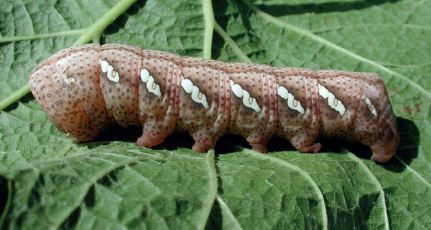
D. Larva of the achemon sphinx, brown morph. HAROLD LARSEN, COLORADO STATE UNIVERSITY

E. Larva of the achemon sphinx, green morph. WHITNEY CRANSHAW

F. Larva of the great ash sphinx. WHITNEY CRANSHAW

G. Catalpa sphinx larva, light phase. HERBERT A. “JOE” PASE III, TEXAS A&M FOREST SERVICE, BUGWOOD.ORG

H. Catalpa sphinx larva, dark phase. DAVID SHETLAR

I. Adult of the achemon sphinx. WHITNEY CRANSHAW

J. Adult of the catalpa sphinx. HERBERT A. “JOE” PASE III, TEXAS A&M FOREST SERVICE
SWEETPOTATO HORNWORM (Agrius cingulata), also known as PINK-SPOTTED HAWK MOTH, is a tropical and subtropical species that feeds on sweetpotato and some related weeds. It is common in the southern U.S., occasionally straying into the Midwest.
Hornworms in the genus Hemaris are among the smallest in the family. Adults, sometimes known as “CLEARWING SPHINX” or “BUMBLE BEE CLEARWINGS” often fly during the day. They have an unusual appearance, with wings largely clear of scales and a heavy body form so they somewhat resemble a large bumble bee. Larvae develop on various shrubs, including honeysuckle, snowberry, cherry, plum, and cranberry. HUMMINGBIRD CLEARWING (H. thysbe), found primarily in eastern North America, and the broadly distributed SNOWBERRY CLEARWING (H. diffinis) are the dominant species.
Poplar and willow host many kinds of hornworms. TWINSPOTTED SPHINX (Smerinthus jamaicensis) and ONE-EYED SPHINX (S. cerisyi) are both quite common in northern areas. Twinspotted sphinx occurs primarily in the eastern half of the northern U.S. and southern Canada and one-eyed sphinx in the western half, although ranges overlap. Some of the largest sphinx moths are the BIG POPLAR SPHINX (Pachysphinx occidentalis) and the MODEST SPHINX (P. modesta), restricted to the western half of North America.
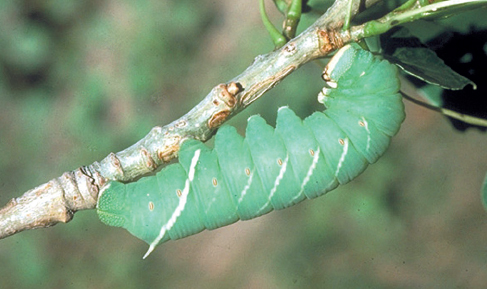
Late-instar larva of the modest sphinx, Pachysphinx modesta. DAVID LEATHERMAN

Pair of western poplar sphinx. WHITNEY CRANSHAW
1 Lepidoptera: Sphingidae
A. Adult sweetpotato hornworm. KARAN A. RAWLINS, UNIVERSITY OF GEORGIA, BUGWOOD.ORG

B. Sweetpotato hornworm larvae, showing different color morphs. FOREST AND KIM STARR, STARR ENVIRONMENTAL, BUGWOOD.ORG

C. Adult of the hummingbird clearwing moth. DAVID CAPPAERT

D. Larva of the hummingbird clearwing moth. WHITNEY CRANSHAW

E. Adult of the hummingbird clearwing moth. DAVID SHETLAR
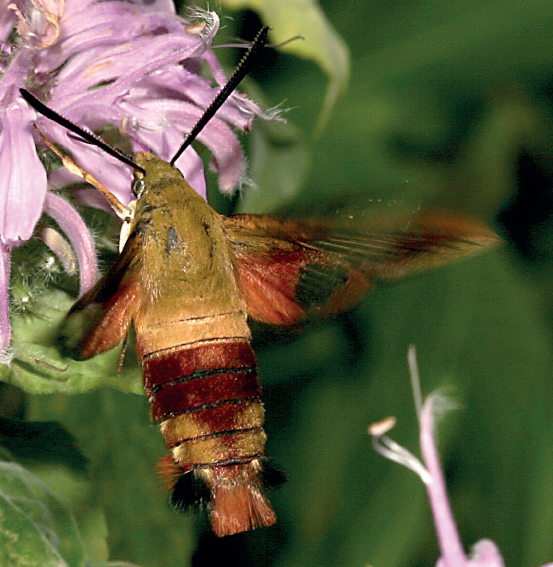
F. Snowberry sphinx. JIM KALISCH, UNIVERSITY OF NEBRASKA

G. Larva of the snowberry sphinx. JIM KALISCH, UNIVERSITY OF NEBRASKA

H. Adult of the twinspotted sphinx. HOWARD ENSIGN EVANS.
Several caterpillars of the prominent moth family (Notodontidae) are associated with trees and shrubs. In general form, the caterpillars somewhat resemble climbing cutworms but often have distinct markings or fleshy projections. A few species are pests of trees and shrubs, and these are usually observed feeding in groups. In response to disturbance, members of the feeding group typically arch and twitch to deter predators.
WALNUT CATERPILLAR (Datana integerrina)1
HOSTS Walnut, butternut, pecan, and hickory.
DAMAGE Larvae chew leaves, first skeletonizing and later consuming most of the leaf except for main veins.
DISTRIBUTION Much of the eastern U.S. but particularly common in the central and southcentral states.
APPEARANCE Full-grown caterpillars are about 2 inches long, dark purple to gray, with some thin white to yellow stripes along the sides of a body generally clothed in long hairs. When disturbed, a group of larvae usually arch their heads and abdomens in a defensive posture. Adults are moderate-sized brown moths with a wingspan of about 2 inches and are marked with some dark lines.
LIFE HISTORY AND HABITS Winter is spent as a pupa, in a cell constructed in soil in the vicinity of previously infested trees. Adults emerge in mid- to late spring, and females lay eggs in masses. Upon hatching, the caterpillars feed gregariously, first skeletonizing leaves and later feeding more generally. Larvae periodically migrate from foliage to large branches and trunks, where they rest in masses and molt, often in synchrony. The full-grown caterpillars often wander considerable distances before pupating. Two generations are produced in the southern states, with adults emerging in midsummer. One generation is common in northern areas.
OTHER NOTODONTIDS/PROMINENT MOTHS ON SHADE TREES
YELLOWNECKED CATERPILLAR (Datana ministra) is a common species in the Appalachian Mountains and may occur in much of the eastern U.S. The caterpillars are marked with a bright yellow patch behind the head. Young larvae are first orange but turn black in the later instars. They have a wide host range, including many deciduous fruit, nut, and shade trees. AZALEA CATERPILLAR (D. major) is often a serious defoliator of azalea in the southeastern U.S. The caterpillars are brightly patterned, yellow and black with a red head and legs. One generation per year is typical, with peak injury in mid- to late summer.

B. Walnut caterpillar, adult. DAVID SHETLAR

C. Walnut caterpillar egg mass. HERBERT A. “JOE” PASE III, TEXAS A&M FOREST SERVICE, BUGWOOD.ORG

D. Walnut caterpillars massed on branch. DAVID SHETLAR

E. Walnut caterpillars at egg hatch. DAVID SHETLAR

F. Yellownecked caterpillars. DAVID SHETLAR

G. Yellownecked caterpillars. DAVID SHETLAR
REDHUMPED CATERPILLAR (Schizura concinna) is probably the most commonly encountered and widespread of the prominent caterpillars in North America. Caterpillars are marked with a pronounced reddish hump behind the head, and during early development they feed gregariously, sometimes stripping individual branches. Apple and crabapple are among the common hosts, although this species develops on many woody plants. One generation is produced per year. The closely related UNICORN CATERPILLAR (S. unicornis) is an unusual brown and green caterpillar with a large fleshy projection on the first segment of the abdomen. Of very similar appearance is FALSE UNICORN CATERPILLAR (S. ipomoeae), sometimes known as “morning glory prominent.” Dark markings on the head and abdomen, absent on false unicorn caterpillar, can distinguish the larvae. Both species of unicorn caterpillars are found throughout most of North America and may feed on a wide range of deciduous trees and shrubs.
ORANGEHUMPED MAPLEWORM (Symmerista leucitys) is a northern species that develops primarily on sugar maple. The caterpillars have an orange-red head and longitudinal black, yellow, and white striping with an orange marking on the hind end. Young stages feed gregariously and skeletonize the upper leaf surface. Older caterpillars are solitary and feed along the leaf margins. REDHUMPED OAKWORM (S. canicosta) also occurs in the northeastern U.S. and southeastern Canada, where it develops primarily on white and bur oak. Basswood, sugar maple, paper birch, beech, and elm are less common hosts.
SADDLED PROMINENT (Heterocampa guttivitta) is a caterpillar of bizarre appearance. First-instar larvae have black antler-like horns behind the head that are lost at the first molt. Full-grown caterpillars are about 1½ inches long, generally green with an orange-red “saddle marking” on the middle. The species is most common in New England. VARIABLE OAKLEAF CATERPILLAR (Lochmaeus manteo) occurs over a broader area of eastern North America, from southern Ontario to northern Texas. White oak is the preferred host, but several other trees are occasionally infested. Damage is most common in the southern states, where two generations per year can occur. This caterpillar can also cause blistering of exposed skin from a formic acid mixture it can spray when disturbed.
The CALIFORNIA OAKWORM (Phryganidia californica)1 is a common caterpillar along coastal areas of California and southern Oregon and is associated with coast live oak. Caterpillars survive the winter as early-stage larvae on the underside of leaves, causing minor skeletonizing. They rapidly develop during early spring and may defoliate trees during outbreaks. They then pupate on bark of trunks, suspended from limbs or on nearby vegetation. Adults, which are tan-gray moths with a wingspan of approximately 1¼ inches, are weak fliers and subsequently lay their eggs in the near vicinity of previously infested plants. Eggs are laid as small masses on twigs or leaves during late summer and early fall. Two generations per year are normally produced; a third generation is sometimes produced if favorable conditions occur.
1 Lepidoptera: Notodontidae
A. Redhumped caterpillar. LACY L. HYCHE, AUBURN UNIVERSITY, BUGWOOD.ORG

B. Unicorn caterpillar. JIM KALISCH, UNIVERSITY OF NEBRASKA

C. False unicorn caterpillar. LACY L. HYCHE, AUBURN UNIVERSITY, BUGWOOD.ORG

D. Adult of the unicorn caterpillar. JIM KALISCH, UNIVERSITY OF NEBRASKA

E. Orangehumped oakworm. USDA-FOREST SERVICE REGION 2, BUGWOOD.ORG

F. Redhumped oakworm. BRUCE WATT, UNIVERSITY OF MAINE, BUGWOOD.ORG

G. Saddled prominent. BRUCE WATT, UNIVERSITY OF MAINE, BUGWOOD.ORG

H. Variable oakleaf caterpillar. WHITNEY CRANSHAW

I. California oakworm. JACK KELLY CLARK, UNIVERSITY OF CALIFORNIA STATEWIDE IPM PROGRAM
The giant silkworms (Saturniidae family) include the largest caterpillars that can be encountered, with some more than 5 inches long. All feed on leaves of trees and shrubs, and individual caterpillars consume impressive amounts toward the end of their life cycle, usually in mid- to late summer. Rarely are they abundant enough to cause significant injury; however, their presence is mostly a curiosity—or even a source of wonder—because of their large size and appearance. Furthermore, populations of several species have been in sharp decline for many years, due to several human-assisted causes.
Adults, often known as royal moths, are large moths that may have a wingspan exceeding 6 inches. Adults do not feed and thus die a few days after emergence from the cocoon. Moths are usually present in late spring or early summer.
CECROPIA MOTH (Hyalophora cecropia)1
HOSTS At least 50 species of deciduous trees and shrubs are hosts of larvae. Boxelder, sugar maple, wild cherry and plum, apple, alder, birch, dogwood, willow, lilac, ash, and viburnum are common hosts.
DAMAGE Cecropia moth caterpillars can be among the most conspicuous late-season defoliators of shrubs. Because the feeding occurs late in the season, however, it causes little, if any, plant injury.
DISTRIBUTION Primarily east of the Rockies.
APPEARANCE The larvae are large, sluggish, sea green caterpillars, from 3 to 4 inches long. They possess numerous colored knoblike tubercles—pale blue along the sides, orange on the thorax, and yellow on the abdomen. Adults are large and colorful moths with a wingspan of 5½ to 6½ inches. They have brownish gray wings with white crescent-shaped eyespots, a dark spot near the tip of each forewing, and red-bordered crossbands on the abdomen. The pupa develops in a tough cocoon attached along its entire length to a twig.
LIFE HISTORY AND HABITS Winter is spent as a pupa in the cocoon, usually attached to a small branch. Adults emerge in late spring. They do not feed, but they mate and females lay eggs on twigs over the course of a few days before dying. The caterpillars then begin to feed on leaves and develop over a period of 2–3 months. All stages of cecropia moth caterpillars bear prominent tubercles on the body, but the caterpillars develop more intense coloration as they age. One generation is produced per year.

Cocoon of the cecropia moth. DAVID SHETLAR
OTHER GIANT SILKWORMS/ROYAL MOTHS
HICKORY HORNED DEVIL (Citheronia regalis)1 is a caterpillar of bizarre appearance that may be 5 inches long. Generally blue green, it has numerous spikes, particularly two long curving pairs on the thorax, giving it a rather dragonlike appearance. It is found in much of the eastern U.S., being more common in the southern states. Hickory, walnut, and a few other trees and shrubs may host the caterpillars. When feeding is completed, the larvae descend trees and walk about in search of soil in which to pupate. Adults are large moths with prominent orange markings and stripes known as REGAL MOTHS.

B. Late-instar cecropia moth caterpillar. JOHN GHENT, BUGWOOD.ORG

C. Cecropia moth eggs. JIM KALISCH, UNIVERSITY OF NEBRASKA

D. Early-instar cecropia moth caterpillars. JIM KALISCH, UNIVERSITY OF NEBRASKA

E. Hickory horned devil, full-grown larva. DAVID SHETLAR

F. Hickory horned devil, young larva. DAVID SHETLAR

G. Regal moths, adults of the hickory horned devil. DAVID SHETLAR
LUNA MOTH (Actias luna)1 is one of the most distinctive moths of North America, having pale green wings developed into an elongate “swallowtails” and marked with a yellow spot. Larvae are translucent pale green with a pale yellow line along the lower side and feed on a wide variety of nut, fruit, and shade trees. The species is known from parts of Texas and Nebraska eastward but has become considerably less abundant in recent decades.
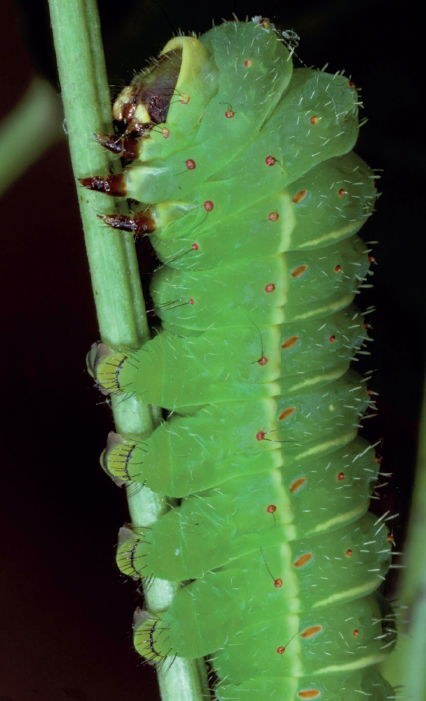
Caterpillar of the luna moth. GERALD J. LENHARD, LOUISIANA STATE UNIVERSITY, BUGWOOD.ORG
Larvae of POLYPHEMUS MOTH (Antheraea polyphemus)1 are stout-bodied, apple green, and only sparsely marked by spines. This species is widely distributed throughout much of North America and feeds on many deciduous trees and shrubs in late summer. Dogwood, oak, willow, maple, and birch are among the common plants on which the caterpillars develop.

Cocoon of the Polyphemus moth cut away to expose pupa. WHITNEY CRANSHAW
Caterpillars of PROMETHEA MOTH (Callosamia promethea)1 are pale bluish green and possess four prominent red-orange spikes near the head and one yellow spike near the rear. They occur in the eastern U.S. and southeastern Canada. Hosts include cherry, magnolia, tuliptree, ash, and lilac. The closely related TULIPTREE SILKMOTH (C. angulifera) develops solely on tuliptree and with a distribution in eastern North America that matches its host plant.

Promethea moth caterpillar. TOM MURRAY
IMPERIAL MOTH (Eacles imperialis)1 develops on a wide range of shade trees, including some conifers as well as deciduous trees. Most often the caterpillars are green and covered with short, light blue-green hairs. Darker morphs sometimes occur that are largely brown or even black.

B. Polyphemus moth caterpillar. DAVID SHETLAR

C. Caterpillar of the promethea moth. GERALD J. LENHARD, LOUISIANA STATE UNIVERSITY, BUGWOOD.ORG

D. Polyphemus moth. DAVID SHETLAR

E. Imperial moth caterpillar. LACY L. HYCHE, AUBURN UNIVERSITY, BUGWOOD.ORG

F. Imperial moth caterpillar. JIM KALISCH, UNIVERSITY OF NEBRASKA

G. Imperial moth. JIM KALISCH, UNIVERSITY OF NEBRASKA
PANDORA MOTH (Coloradia pandora)1 is a western species associated with pines. It has had several historical outbreaks, and the caterpillars have sometimes been used as a food source by Native Americans. The life cycle requires 2 years to complete, with partially grown larvae wintering on the tree during the first year and then moving to the soil to pupate in a cocoon following the second year.
GREENSTRIPED MAPLEWORM (Dryocampa rubicunda)1 is associated with maple throughout the eastern U.S. and is particularly common in the southern half of its range where outbreaks sometimes are recorded. Caterpillars possess a cherry red head and yellow-green body with seven dark green lines running the length. The insect is also marked with two slender, flexible horns behind the head. ORANGESTRIPED OAKWORM (Anisota senatoria)1 occurs in much of the eastern half of the U.S., excluding some of the southeastern states. It feeds on oak and occasionally causes extensive defoliation in late summer. SPINY OAKWORM (A. stigma) is marked by two prominent spines on the thorax. It ranges east from southern Ontario to parts of Texas and develops on oak and hazel.
IO MOTH (Automeris io)1 is one of the smaller giant silkworms, reaching about 3 inches when mature. The larvae possess numerous stinging hairs that produce a painful reaction on touch. Io moth caterpillars are the most widespread and commonly encountered of the caterpillars in North America that can produce painful stings.
Larvae are large, pale green caterpillars with a lateral stripe of pink and creamy white down each side, covered with clusters of branching spines. They develop on a wide range of deciduous shade trees including willow, elm, apple, maple, hickory, and sycamore and are about 3 inches long at maturity. Pupation occurs in a cocoon, and the stinging hairs of the larvae coat the cocoon. Adults have a wingspan of 2½ to 3 inches, the females with lightly patterned purplish red wings, the males smaller with yellowish wings, and both with a large circular black eyespot on the hindwings. One generation is produced in most areas, but two can occur in the more southern states.
A few species of Hemileuca1 species, sometimes known as “buck moths,” are occasional tree pests. Older larvae are generally dark and possess numerous tufts of branched spines. The spines are attached to poison glands capable of producing a painful sting, although not as painful as that of Io moth. The most common western species, NEVADA BUCK MOTH (H. nevadensis), develops on poplar and willow. EASTERN BUCK MOTH (H. maia) is an eastern species that feeds on scrub, live, blackjack, and dwarf chestnut oak. NEW ENGLAND BUCK MOTH (H. lucina) is restricted to the New England States and feeds on oak, black cherry, willow, gray birch, and blueberry. Adults of all buck moths are fairly large, fly during fall days, and have wings prominently patterned with white and black. Egg masses survive winters and the larvae feed over much of the spring and summer months.
1 Lepidoptera: Saturniidae

B. Greenstriped mapleworm adult. WILLIAM CIESLA, FOREST HEALTH MANAGEMENT INTERNATIONAL, BUGWOOD.ORG

C. Greenstriped mapleworm. GERALD J. LENHARD, LOUISIANA STATE UNIVERSITY, BUGWOOD. ORG

D. Orangestriped oakworm. DAVID SHETLAR.

E. Spiny oakworm. DAVID SHETLAR

F. Io moth caterpillar. STEVEN KATOVICH, USDA-FOREST SERVICE, BUGWOOD.ORG

G. Adult of the Io moth. RONALD J. BILLINGS, TEXAS A&M FOREST SERVICE, BUGWOOD.ORG
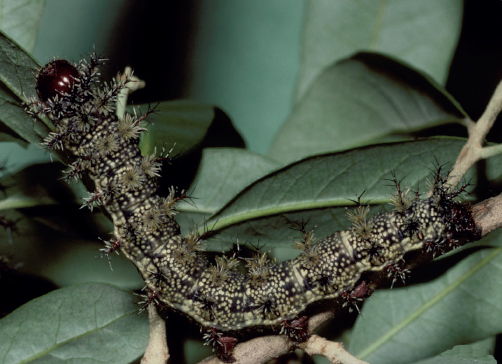
H. Caterpillar of the eastern buck moth, Hemileuca maia. GERALD J. LENHARD, LOUISIANA STATE UNIVERSITY, BUGWOOD.ORG

I. Adult of the eastern buck moth, Hemileuca maia. GERALD J. LENHARD, LOUISIANA STATE UNIVERSITY, BUGWOOD. ORG
SLUG CATERPILLARS/FLANNEL MOTHS AND OTHER STINGING CATERPILLARS
The slug caterpillars (Limacodidae) are often bizarre in appearance and attract attention but are rarely abundant. Most larvae possess prominent spines and bright coloration and may be an unusual shape. The spines are highly irritating upon contact and can produce a painful reaction. Because of the stinging hairs, some species are locally known as “asps.”
SADDLEBACK CATERPILLAR (Sibine stimulea)1 is among the most commonly encountered species, found in much of the eastern half of the U.S. and particularly abundant in the Atlantic States. Larvae are brown with a pronounced green saddle-shaped area over the center of the body. Colorful sharp spines, connected to poison gland cells, extend from both front and back and are extremely painful. Saddleback caterpillars feed on apple, pear, cherry, corn, canna, lily, dahlia, and many other plants but are never abundant enough to cause serious plant injury. The pupa occurs in a cocoon, and the stinging hairs are retained on the surface. Adults fly in July and August in the north and year-round in the extreme south. STINGING ROSE CATERPILLAR (Parasa indetermina)1 also has tufts of stinging hairs, but the general color is reddish or orange red with striping down the center of the back. Common hosts include wild rose, redbud, oak, hickory, bayberry, wild cherry, and sycamore. Two Euclea1 species (E. delphinii, E. nanina) with stinging hairs, known as “SPINY OAK SLUGS” feed on a wide variety of trees and shrubs in eastern North America.
Caterpillars of HAG MOTH (Phobetron pithecium)1 have numerous long, curved spines along the sides and particularly enlarged areas on the third, fifth, and seventh segments. The spines are connected to poison glands, and contact with the spines produces a painful reaction. Larvae feed on many deciduous trees and shrubs, including wild rose, sassafras, alder, and spirea.
Another species with stinging hairs that is common in parts of the southern U.S. is PUSS CATERPILLAR (Megalopyge opercularis).2 Larvae are densely covered in long hairs that may be yellowish, reddish brown, or mouse gray. The young larvae typically feed in groups, skeletonizing the leaf surfaces of many deciduous trees including oak, elm, hackberry, and sycamore. Two generations are produced annually.
A related species that occurs in the southeastern U.S. is HACKBERRY LEAF SLUG (Norape ovina).2 Larvae have six small tufts of stinging hairs on each segment and feed on several woody plants, particularly redbud, red maple, and hackberry. The adult is known as the WHITE FLANNEL MOTH. A related species found in southwestern states that also has stinging hairs is MESQUITE STINGER (N. tenera).
1 Lepidoptera: Limacodidae
2 Lepidoptera: Megalopygidae

B. Stinging rose caterpillar. LACY L. HYCHE, AUBURN UNIVERSITY, BUGWOOD.ORG

C. Adult of the stinging rose caterpillar. LACY L. HYCHE, AUBURN UNIVERSITY, BUGWOOD.ORG

D. A spiny oak slug. BRUCE WATT, UNIVERSITY OF MAINE, BUGWOOD.ORG

E. Caterpillar of the hag moth. JERRY A. PAYNE, USDA-ARS, BUGWOOD.ORG

F. Puss caterpillar. DAVID SHETLAR

G. Hackberry leaf slugs. LACY L. HYCHE, AUBURN UNIVERSITY, BUGWOOD.ORG
The term “tussock moth” is loosely applied to certain caterpillars, within two families, that are thickly covered with hairs and have patches of hairs clumped together in dense tufts. The hairs of many species can be very irritating to skin and eyes.
WHITEMARKED TUSSOCK MOTH (Orygia leucostigma)1
HOSTS A wide variety of trees and shrubs, including apple, basswood, elm, sycamore, maple, birch, pyracantha, live oak, mimosa, and redbud. Some conifers are occasional hosts.
DAMAGE Larvae chew leaves, occasionally causing significant defoliation.
DISTRIBUTION Generally distributed east of the Great Plains. Also known from British Columbia.
APPEARANCE Larvae are cream-colored overall with coral red heads. On four segments of the abdomen distinctive brushlike tufts of white or yellowish hairs are present, and there are pencil-like tufts of hairs at both the hind and front ends. Adult females are wingless, about ½ inch in length. Adult males are grayish brown with a wingspan of about 11/5 inches and a distinctive white spot at the base of the forewing.
LIFE HISTORY AND HABITS Winter is spent as eggs that were laid adjacent to wherever females previously pupated. Eggs hatch in mid- to late spring, and the early-stage larvae skeletonize leaves. Later-stage larvae feed more generally and become full grown 3–4 weeks after egg hatch. They often wander a considerable distance before pupating, and the pupal stage occurs in a cocoon mixed with hairs of the larvae. A second generation is common in much of the range, with peak feeding in midsummer.
RELATED AND SIMILAR SPECIES
DOUGLAS-FIR TUSSOCK MOTH (Orgyia pseudotsugata)1 is a western species ranging from Colorado into the Pacific Northwest. It feeds on spruce, Douglas-fir, and white fir. Overwintered egg masses hatch shortly after bud break, and the young larvae first consume emergent new growth. Defoliation typically is concentrated on the upper areas of the plant, and serious defoliation can cause tree crowns to die and trees to become susceptible to bark beetles. Sensitization to the hairs of the caterpillars is reported in some people following outbreaks of this insect, particularly when the full-grown larvae wander off the tree in search of pupation sites. Males can fly but females are wingless, mating and laying eggs among the cocoon and pupal skin fragments in early summer. One generation is produced per year.
WESTERN TUSSOCK MOTH (O. vetusta) is found throughout the Pacific States. Larvae develop on various fruit and nut trees, hawthorn, manzanita, oak, pyracantha, toyon, walnut, and willow. Two cycles of feeding occur annually, in spring and in late summer/early fall. RUSTY TUSSOCK MOTH (O. antiqua) is widely distributed and found throughout much of the northern U.S., southern Canada, and into northern California. It is rarely seriously damaging but has a wide host range including many hardwood trees and shrubs and conifers. The common name relates to the rusty color of the adult male moth.
Caterpillars of the MILKWEED TUSSOCK MOTH (Euchaetes egle)1 feed on the leaves of various milkweeds and, occasionally, on dogbane. Eggs are laid as masses on the underside of leaves and the early-stage larvae feed as a group. Later larvae disperse throughout the plant and develop prominent tufts of black, white, and orange hairs. Milkweed tussock moth occurs throughout eastern North America and undergoes two generations per year.
A. Whitemarked tussock moth. DAVID CAPPAERT, BUGWOOD.ORG

B. Female whitemarked tussock moth laying eggs. DAVID SHETLAR

C. Douglas-fir tussock moth egg mass at hatching. DAVID LEATHERMAN

D. Douglas-fir tussock moth caterpillar. WILLIAM CIESLA, FOREST HEALTH MANAGEMENT INTERNATIONAL, BUGWOOD.ORG

E. Adult male Douglas-fir tussock moth. DAVID LEATHERMAN

F. Adult female Douglas-fir tussock moth next to cocoon. JERALD E. DEWEY, USDA-FOREST SERVICE, BUGWOOD.ORG

G. Western tussock moth caterpillar. DAVID SHETLAR

H. Milkweed tussock moth caterpillar. DAVID SHETLAR
SATIN MOTH (Leucoma salicis)1 is a European species found in the northeastern and northwestern U.S. and adjacent areas of Canada. Several shade trees and shrubs are hosts, including poplar, willow, aspen, and oak. The life history is unusual, with winter spent as a partially grown larva in a silken bag attached to a tree, a habit somewhat resembling that of bagworms (page 116). Peak feeding occurs when the larvae emerge to feed on new growth in spring. The pupa is jet black and is produced in late spring, with adults active in early summer. Eggs are produced during this time. They later hatch and produce larvae that feed for a brief period as leaf skeletonizers, until they move to winter shelters.
HICKORY TUSSOCK MOTH (Lophocampa caryae)1 feeds from July through September on a wide range of deciduous trees and shrubs, including nut trees, apple, basswood, oak, and birch. Eggs are laid in masses, and subsequent early-stage caterpillars feed as a group, later dispersing. All stages of the caterpillars have a black head and are pale yellow, often becoming white as they complete development. Pupation in a cocoon occurs around the base of plants and is the wintering stage. Hickory tussock moth occurs over the northeastern quarter of the U.S. and in southeastern Canada. SYCAMORE TUSSOCK MOTH (L. harrisii) develops on sycamore and plane tree in the eastern U.S. Eggs are laid in late spring with subsequent peak larval feeding in mid- to late summer. Caterpillars of BANDED TUSSOCK MOTH (Halysidota tessellaris),1 also known as the “pale tussock moth,” feed on various flowers as well as the foliage of sycamore, alder, oak, hickory, and other plants.
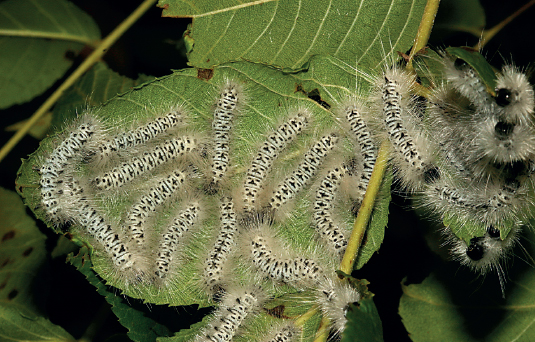
Hickory tussock moth caterpillars. DAVID SHETLAR
OLEANDER CATERPILLAR (Syntomeida epilais)1 feeds on oleander in Florida and southern Georgia. Eggs are laid as masses, and the caterpillars feed in groups, moving up and down the plant as they get older. They are hairy caterpillars, bright orange with tufts of long black hairs. At pupation they continue to aggregate, pupating in a group. Adults are steel blue in color with polka-dotted wings and an orange tip to the abdomen. Moths fly during the day. A related species that feeds on oleander, SPOTTED OLEANDER CATERPILLAR (Empyreuma affinis)2 occurs in extreme southern Florida and the Florida Keys.
AMERICAN DAGGER MOTH (Acronicta americana)2 is a predominately yellow caterpillar with dark tufts of pencil-hairs. It feeds primarily on maple and boxelder, infrequently on apple, basswood, oak, and willow. The caterpillars feed at night and have the unusual habit of cutting the partially consumed leaf at the petiole before retreating to daytime shelter. This species is widely distributed east of the Rockies. Related species that feed on poplar, cottonwood, and willow are COTTONWOOD DAGGER MOTH (A. lepusculina) and POPLAR DAGGER MOTH (A. leporina). Habits and general appearance of the caterpillars are similar to those of American dagger moth.

Caterpillar of the poplar dagger moth. DAVID SHETLAR
1 Lepidoptera: Erebidae
2 Lepidoptera: Noctuidae
A. Satin moth caterpillar. BRUCE WATT, UNIVERSITY OF MAINE, BUGWOOD.ORG

B. Sycamore tussock moth caterpillar. JAMES SOLOMON, USDA-FOREST SERVICE, BUGWOOD.ORG

C. Caterpillar of the banded (pale) tussock moth. BRUCE WATT, UNIVERSITY OF MAINE, BUGWOOD.ORG

D. Adult of the oleander caterpillar laying eggs. DOUG CALDWELL, UNIVERSITY OF FLORIDA

E. Spotted oleander caterpillar (above) and oleander caterpillar (below). DOUG CALDWELL, UNIVERSITY OF FLORIDA

F. Adults of the American dagger moth. WHITNEY CRANSHAW

G. Caterpillar of the American dagger moth. DAVID SHETLAR
GYPSY MOTH (Lymantria dispar)1
HOSTS Caterpillars of the gypsy moth feed on an extremely wide range of plants. Oak and aspen are among the trees that are particularly favored, but plants as diverse as hemlock, white pine, and poison ivy are also eaten by gypsy moth caterpillars.
DAMAGE Larvae chew leaves of plants during late spring. Gypsy moth is an outbreak species of forests and causes extensive defoliation during outbreak events. Outbreaks persisting for two or more consecutive years produce significant weakening of plants so they become disposed to secondary pests, such as twolined chestnut borer. Droppings (frass) and leaf fragments produced by caterpillar outbreaks can produce serious nuisance problem issues.
DISTRIBUTION Since its original, accidental introduction outside Boston in 1868, gypsy moth has steadily extended its range. It is currently found in a broad swath over much of the northern U.S. as far west as parts of eastern Minnesota and southward into the Carolinas. Isolated infestations have been found in almost every state because of the movement of egg masses on plant materials and other infested items moved in commerce.
A strain subspecies of the gypsy moth native to parts of Russia, known as ASIAN GYPSY MOTH, produces females that are capable of flight. This insect has on occasion been introduced into the Pacific Northwest. Strong efforts to limit its introduction and to eradicate known infestations are ongoing by government agencies in both the U.S. and Canada.
APPEARANCE Larvae are generally mottled gray and have pairs of colored tubercules, blue in front and red in back. They have numerous hairs on the body that can be irritating to human skin. Male moths are generally dark brown with wavy darker markings across the wings. Females have wings that are generally white with dark wavy stripes; however, they are incapable of flight.
LIFE HISTORY AND HABITS Winter is spent as eggs laid in a mass covered with hairs from the body of the female. Eggs usually hatch in April, and the young larvae often move to the tips of branches where many may be dispersed by wind (ballooning). Larval development typically involves five (male) or six (female) caterpillar stages (instars) completed over the course of about 6 weeks. Most feeding occurs at night, with the larvae moving to trunks and branches during the day to rest and molt. Later stages often feed during the day, however, particularly during outbreaks.
The larvae may settle on plants for pupation or wander and pupate on rocks, adjacent vegetation, sides of buildings, and other upright surfaces in the vicinity. The pupa is naked and only loosely covered with and attached by silk. Adults emerge about 2 weeks later. The male adult is a strong flier, but females are flightless and lay eggs near where they pupate. After mating, females lay a single egg mass, typically containing more than 250 eggs and covered with pale yellow hairs from the female’s abdomen. The eggs require an extended cold period for hatching and remain dormant until the following spring.
1 Lepidoptera: Erebidae
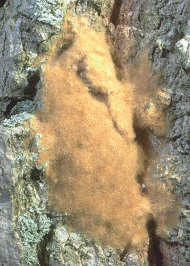
B. Egg mass of the gypsy moth. DAVID SHETLAR

C. Adult male gypsy moth. DAVID SHETLAR

D. Adult female gypsy moth laying eggs. DAVID SHETLAR

E. Gypsy moth egg mass at egg hatch. DAVID SHETLAR

F. Larvae and pupae of gypsy moth on a tree trunk. DAVID SHETLAR
The term “woollybear” is loosely applied to some densely hairy caterpillars formerly of the family Arctiidae (now family Erebidae, subfamily Arctiinae). The term “woollybear” is most commonly used for those species that can be observed wandering on the ground late in the growing season.
YELLOW WOOLLYBEAR (Spilosoma virginica)1 is a generalist leaf feeder that can occur on almost all garden plants and is very widely distributed in North America. The caterpillars are covered with fine hairs of uniform color. Young stages are always quite pale, and yellowish coloration predominates throughout development. Brown forms sometimes occur. Adults have nearly pure white wings that span 1½ to 2 inches. One black spot occurs on the forewing, three spots on the hindwing.
Winter is spent as a pupa in a loose cocoon mixed with hairs from the larvae, under debris and other protected sites around the soil surface. First-generation adults emerge in midspring, and females lay eggs in masses on leaves. The newly hatched larvae originally feed as a group and skeletonize the undersurface of leaves. They disperse and feed more generally as they get older. They then pupate and produce a second generation. Those that do not go into winter dormancy at this point produce a third generation, after which the overwintering pupae occur.
SALTMARSH CATERPILLAR (Estigmene acrea)1 is the most common damaging species of woollybear, particularly in the southwestern U.S. Feeding habits are similar to those of yellow woollybear. Caterpillars are originally dark brown but later turn variable colors, including yellowish brown or black. Winter is spent as a mature larva in the cocoon, and pupation occurs in spring. The adult, known as the ACREA MOTH, has white forewings marked with numerous dark spots. Hindwings of the male are yellow, of the female white. There may be three or four generations a year in southern areas, a single generation in the north.
BANDED WOOLLYBEAR (Pyrrharctia isabella)1 rarely damages crops, limiting most feeding to a wide range of weeds. The caterpillar is well recognized, however, by its broad brown central band bordered by black. The central band does tend to widen as the caterpillars mature, but there is no basis for the folk legend that its relative width predicts the severity of the upcoming winter. Winter is spent as a nearly full-grown caterpillar that resumes feeding for a brief period the following spring before pupating. Adults are known as ISABELLA MOTHS. One to two generations are produced annually.
1 Lepidoptera: Erebidae (Arctiinae)

B. Yellow woollybear. WHITNEY CRANSHAW

C. Adults of the banded woollybear. WHITNEY CRANSHAW

D. Adult of the yellow woollybear. DAVID SHETLAR

E. Saltmarsh caterpillar. WHITNEY CRANSHAW

F. Saltmarsh caterpillar. WHITNEY CRANSHAW

G. Saltmarsh caterpillar adult with egg masses. ROBERT HAMMON
CLIMBING CUTWORMS AND ARMYWORMS
Caterpillars in the family Noctuidae that feed at or just below the soil and that cut plants are usually known as cutworms. These species are covered in chapter 6 with other insects found associated with soil and roots. In addition, there are many species of “climbing cutworms” that do not restrict feeding to the soil surface and that climb plants, usually at night, to chew leaves, buds, and developing fruit. Those that have a habit of feeding aboveground and also becoming abundant at times and occurring in large migrations may also be known as “armyworms.” Adult stages of cutworms and armyworms are moderately large gray or brown moths, usually with indistinct markings.
VARIEGATED CUTWORM (Peridroma saucia)1
HOSTS Variegated cutworm has arguably the widest range of host plants of any caterpillar that occurs in North America; it is damaging to vegetables, many fruit crops, and field crops. Potato, pea, cabbage, lettuce, mint, and tomato are among the garden crops most commonly damaged.
DAMAGE Larvae feed on foliage, buds, and shoots and may cut seedlings. Existing fruit may be tunneled. Potato tubers are gouged by feeding larvae.
DISTRIBUTION Variegated cutworm is a species with very wide host range and can be found throughout North America.
APPEARANCE Larvae are among the most recognizable of the cutworms, with a series of pale yellow spots on the back of most segments. A dark “W” mark is usually present on the eighth abdominal segment. Adult moths are ashy or light dirty brown with some dark brown mottling.
LIFE HISTORY AND HABITS Variegated cutworm usually winters as a pupa in the soil, but it may be active year-round in extreme southern areas. Adults are strong fliers and may disperse over wide areas. Eggs are laid in batches of 60 or more on stems and leaves or on nearby inanimate objects such as fences and buildings. Larvae feed primarily at night but may be active during the day on occasion. The entire life cycle can be completed in 6–8 weeks and 2 generations are usually produced annually in the northern U.S. In warmer areas of the south, as many as 4 generations are sometimes reported.
FALL ARMYWORM (Spodoptera frugiperda)1
HOSTS Primarily grasses, including corn and bermudagrass. Legumes, some vegetables, fruit trees, and flowers are occasionally damaged.
DAMAGE In young corn, larvae tunnel into the whorl and shred the emerging leaves. As ears develop, they tunnel into ears, often entering from the sides as well as the tips. When turfgrass is chewed it has a ragged appearance.
DISTRIBUTION Fall armyworm is a tropical species that irregularly survives winter in the U.S., even in the Gulf States. It is highly dispersive, and migrations from Mexico and Central America occur annually, frequently reaching as far north as New England by early summer.
APPEARANCE Adults are similar to other cutworms, with a wingspan of about 1½ inches and dark gray forewings mottled with lighter and darker patches and crossing lines. There is a noticeable whitish spot near the wing tip. Larvae range from light tan to green or nearly black. A prominent inverted white Y on the head distinguishes this species from armyworm and some other cutworms.
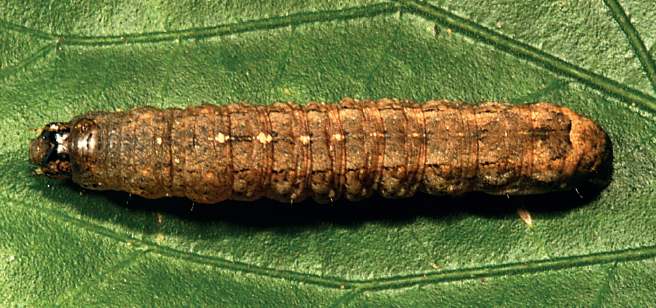
B. Variegated cutworm. DAVID SHETLAR

C. Variegated cutworm pupa. DAVID SHETLAR
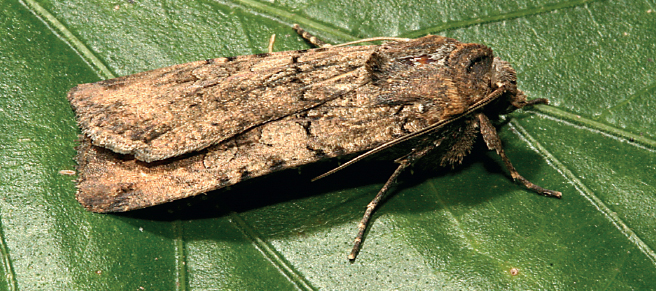
D. Variegated cutworm adult. DAVID SHETLAR

E. Variegated cutworm egg mass. DAVID SHETLAR
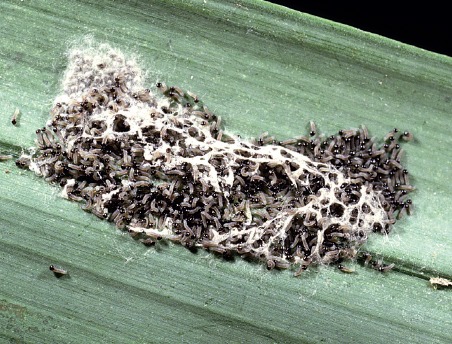
F. Fall armyworm egg mass at hatch. DAVID SHETLAR

G. Fall armyworm egg mass on bentgrass. DAVID SHETLAR

H. Fall armyworm. DAVID SHETLAR

I. Fall armyworm, adult. DAVID SHETLAR
LIFE HISTORY AND HABITS Annual activity begins in spring when adult migrations reach the U.S. or when overwintering pupae emerge as adults in southern states. Eggs are laid at night in masses of about 400 eggs, covered with hairs of the moth. Egg masses are laid directly on corn and other plants, but infestations of turfgrass often result from larvae dispersing from eggs laid on inanimate objects such as goal posts, flagging, and the underside of tree leaves. Younger stages often feed on only a single side of the leaf blade, leaving a transparent outer surface. Older larvae are more general feeders and consume entire areas of the leaf. When populations are abundant and food becomes limiting, fall armyworm larvae may move in masses in an armyworm-like manner. Larval development takes about 2–3 weeks to complete, and pupation occurs in the soil in a loose cocoon. Three or four generations per year are typical for the southern U.S. and one or two in the north.
BEET ARMYWORM (Spodoptera exigua)1
HOSTS A wide range of plants are eaten by beet armyworm, including vegetables such as lettuce, most crucifer crops, beet, tomato, bean, onion, and asparagus. Many herbaceous ornamentals and weeds are also hosts.
DAMAGE Caterpillars feed primarily on foliage but may chew into stems and sometimes upper roots. Beet armyworm may bore into the heada of leafy vegetables, characteristically entering plants from the base.
DISTRIBUTION Beet armyworm is found primarily in the southern U.S., where it can successfully survive winter conditions. It is a highly dispersive species that may sometimes migrate into more northern areas in large numbers, creating occasional outbreaks in more northern areas.
APPEARANCE Caterpillars are smooth and light olive green. Dark lateral stripes and fine wavy light stripes along the back are the primary markings. Adults have slightly mottled grayish brown forewings with a pale spot in the middle of the front margin.
LIFE HISTORY AND HABITS Winter is usually spent as a pupa in a shallow earthen cell. Adults emerge in spring, and females lay eggs in masses. Approximately 80 eggs are laid in a mass, which is then covered with hairs, giving it a cottony appearance. Early-instar larvae feed as a group and skeletonize the leaves. Older larvae disperse and feed singly, often tunneling into plant parts. Beet armyworm larvae can be quite mobile and frequently move between plants. The life cycle can be completed in about a month under normal summer conditions, and four generations are commonly produced annually over much of the range.
OTHER CLIMBING CUTWORMS AND ARMYWORMS
YELLOWSTRIPED ARMYWORM (Spodoptera ornithogalli) and WESTERN YELLOWSTRIPED ARMYWORM (S. praefica) have a wide host range including most vegetables, some flowers, and occasionally even turfgasses. They are sometimes important defoliators of commercial vegetable crops but rarely are serious pests in gardens, with caterpillars often preferring various weeds, including grasses such as foxtails. Yellowstriped armyworm is found over a broad area of the eastern U.S. east of the Rockies but also extends southwest into southern California. Western yellowstriped cutworm predominates in northern California and the Pacific Northwest. Life cycles of both species are similar to that of the beet armyworm.
SOUTHERN ARMYWORM (S. eridania) is a common pest of vegetables in the southeastern states. The larvae are generally dark with prominent yellow stripes running the length of the body. Young larvae feed as a group, skeletonizing leaves. As they get older, they become solitary and may enter fruit, exposed tubers, and stems as well as feed on leaves. Four generations are thought to occur in Florida, with activity from March through October.

B. Beet armyworm larva. JOHN CAPINERA, UNIVERSITY OF FLORIDA

C. Beet armyworm egg mass. JACK KELLY CLARK, COURTESY OF UNIVERSITY OF CALIFORNIA STATEWIDE IPM PROGRAM

D. Beet armyworm larva. RUSS OTTENS, UNIVERSITY OF GEORGIA, BUGWOOD.ORG

E. Yellowstriped armyworm. DAVID SHETLAR

F. Yellowstriped armyworm, adult. DAVID SHETLAR

G. Southern armyworm. RONALD SMITH, AUBURN UNIVERSITY, BUGWOOD.ORG
ARMYWORM (Mythimna unipuncta),1 sometimes known as the “true armyworm,” is primarily a grass feeder. The adult moths are uniformly brown, distinguished by a small white dot in the center of the forewing. The moth is sometimes referred to as the “white-speck” due to this marking. They are strong fliers and may migrate long distances. Eggs are laid in masses of more than 100 eggs, usually among dense grasses or other moist vegetation. Grasses are highly preferred, and armyworm is primarily a pest of small grains and, less commonly, turfgrasses. However, it feeds on a wide variety of plants and can damage most vegetable crops. When populations are abundant and available food has been consumed, armyworm caterpillars will migrate in large masses to seek new food sources.
Armyworm occurs throughout much of North America but is most common east of the Rocky Mountains. The overwintering stage can be variable; both pupae (northern locations) and larvae (southern states) are reported. Four or five generations are produced annually. Outbreaks can be explosive but rapidly decline because of natural controls.
BERTHA ARMYWORM (Mamestra configurata)1 is primarily a pest in the Prairie Provinces and British Columbia but is occasionally damaging in the Pacific Northwest and northern High Plains. It has a wide host range but feeds primarily on crucifers and beet family plants, with wild mustard and lambsquarter being important weed hosts. Other commonly damaged plants include potato, beans, and several garden flowers such as hollyhock, petunia, and zinnia. Moths emerge in June and July, and females lay eggs as masses on the underside of leaves. Young stages are greenish with narrow pale stripes on the back and sides. Later stages become darker, sometimes brownish. Feeding occurs at night, when the larvae work as “climbing cutworms,” chewing leaves and flower buds. Pupation occurs in the soil, in a cell often dug to a depth of 1 foot or more.
The name SPOTTED CUTWORM is applied to two species of similar habit, Xestia c-nigrum1 and X. dolosa. The caterpillars are grayish brown or green with a series of distinct paired black triangular wedges along the back. Spotted cutworms climb foliage and have been reported damaging fruit buds as well as a wide variety of vegetables and garden plants, particularly in summer. Winter is spent in the larval stage, with pupation in spring. One generaton per year is normally produced in Canada and the northern states and up to three generations may develop in southern areas.
WESTERN BEAN CUTWORM (Loxagrotis albicosta)1 is primarily an insect of the western Great Plains. Although beans and tomato are occasionally damaged, it most commonly damages corn. Larvae chew leaves and tunnel ears during late summer. Eggs are laid as masses in late July and August, and larvae may occur in small groups, unlike more solitary cutworms such as corn earworm. After feeding is completed, larvae tunnel into the soil to pupate. One generation is produced annually.
GRANULATE CUTWORM (Agrotis subterranea)1 is the most important cutworm pest of vegetables in the Gulf States and ranges northward to Ohio. Adult females lay eggs directly on foliage, and the young larvae skeletonize leaves as they feed. Older larvae move to the soil during day and feed at night, becoming generalized leaf feeders. Granulate cutworm may cut seedlings, consume leaves, and incidentally damage fruit of a wide range of vegetable crops. It may reproduce continually in southern areas, with all stages present year-round. In Tennessee there are three generations, with winter spent as a pupa.
ZEBRA CATERPILLAR (Melanchra picta)1 is one of the most distinctive garden caterpillars. Black, white, and yellow stripes run the length of the body, and numerous small, alternating black and yellow bands run across the body. This species may feed on several vegetables as well as some flowers but is primarily damaging only to cabbage and related plants. Winter is spent as a pupa in the soil. The adults are chocolate brown moths that lay eggs as masses. The newly hatched larvae feed as a group, skeletonizing the leaf surface. Older larvae disperse and feed more generally on leaves and flowers. Two generations are normally completed annually.

B. Armyworm, adult. WHITNEY CRANSHAW

C. Zebra caterpillar. WHITNEY CRANSHAW

D. Adult of the zebra caterpillar. THE KEN GRAY COLLECTION, OREGON STATE UNIVERSITY

E. Western bean cutworm. JIM KALISCH, UNIVERSITY OF NEBRASKA
EIGHTSPOTTED FORESTER (Alypia octomaculata)1 feeds on grape and Virginia creeper east of the Rockies. The common name refers to the features of the adult, a velvety black moth with paired light markings on each of the four wings. Moths fly during the day and can often be seen visiting flowers for nectar. The caterpillars are white or pale bluish, well patterned with rows of black spotting, orange banding along the side, and a rounded hump on the hind end. They chew leaves from early June through August. Apparently two generations are produced, with adults most common in May and early August. Winter is spent as a pupa in a cocoon in the soil.
OKRA CATERPILLAR (Anomis erosa)1 feeds on leaves of okra and related mallow family plants in the southeastern U.S. Although common, it is rarely abundant enough to cause serious injury. The caterpillars walk in a manner similar to loopers, but they do possess a fourth, albeit small, pair of prolegs. Okra caterpillars are yellowish green or green and have a dark stripe down the back.
One of the few chewing insects that damage ferns is FLORIDA FERN CATERPILLAR (Callopistria floridensis),1 native to many southeastern and Gulf States. The caterpillars have two color phases, either pale green or velvety black, and are marked with two wavy light stripes.
VELVETBEAN CATERPILLAR (Anticarsia gemmatalis) is the most common caterpillar that feeds on leaves of soybean in the southeastern states. It is native to tropical America and occurs in the U.S. as an annual migrant. Other legumes are hosts of this insect, including kudzu, velvetbean, black locust, hairy indigo, and white sweetclover.
The LARGE YELLOW UNDERWING (Noctua pronuba)1 is a European species that has rapidly colonized large areas of the continent. The adult insect is most commonly observed, and its common name is appropriately descriptive as the moths have a wingspan that may exceed 2 inches. Underneath the brown, mottled forewings are bright yellow hindwings, margined with black. The caterpillars feed on a wide variety of plants commonly grown in gardens and may cause damage in spring to plants both near ground level and on aboveground leaves and buds.
It is also the adult stage of the UNDERWING MOTHS (Catocala spp.)2 that is most likely to be seen, often near outdoor lights. These are large moths, typically with wingspans of 2–3 inches. The front wings are grayish, often with wavy patterns, which allow them to blend well with bark of trees. However, the underwings are very brightly colored and patterned, and these may be suddenly flashed when the moth is disturbed. The caterpillars are sometimes called “false loopers,” though they have the full complement of five prolegs. These caterpillars are rarely observed as they blend in well on twigs and small branches. More than 100 species of underwing moths occur in the U.S. and Canada, and the caterpillars of almost all species chew leaves of various trees and shrubs. Oaks, hickory, walnut, birch and beech are among the most common host plants.
1 Lepidoptera: Noctuidae
A. Eightspotted forester, adult. JOHNNY N. DELL, BUGWOOD.ORG

B. Eightspotted forester caterpillar. JOHNNY N. DELL, BUGWOOD.ORG

C. Larva of the large yellow underwing. DAVID SHETLAR

D. Velvetbean caterpillar. CLEMSON UNIVERSITY - USDA COOPERATIVE EXTENSION SLIDE SERIES, BUGWOOD.ORG

E. Scarlet underwing moth, Catocala coccinea. WHITNEY CRANSHAW

F. Florida fern caterpillars. CHAZZ HESSELEIN, ALABAMA COOPERATIVE EXTENSION, BUGWOOD.ORG

G. Caterpillar of the penitent underwing, Catocala piatrix. WHITNEY CRANSHAW
Many insects described as “loopers” are members of the cutworm subfamily Plusiinae. These are characterized by having only three pair of prolegs on the abdomen, versus five pairs found among most other members of the order. This causes them to walk in a looping fashion, somewhat like the inchworms (page 104), the other common caterpillar family that has a reduced number of prolegs (two pairs).
CABBAGE LOOPER (Trichoplusia ni)1
HOSTS Despite its name, cabbage looper is not limited to mustard family plants but may also damage plants as diverse as potato, tomato, pea, lettuce, spinach, nasturtium, and carnation. It is sometimes found as a greenhouse pest on various ornamentals.
DAMAGE Larvae chew leaves of various plants, occasionally causing serious defoliation. Late instars tend to tunnel into heads of cabbage, lettuce, and other plants, causing additional injury.
DISTRIBUTION Throughout North America, common. Cabbage looper thrives best in warmer climates and survives poorly following winters in areas with extended freezing temperatures. Adults, however, are strong fliers and annually migrate long distances.
APPEARANCE Caterpillars are pale green, darkening somewhat as they get older. Faint white stripes run the length of the body. Adults are of moderate size (wingspan about 1½ inches) with mottled gray or brown forewings and a distinctive silvery white U-mark with a single spot below.
LIFE HISTORY AND HABITS Eggs are hemispherical and glued singly to foliage, often in small groups. They hatch in a few days, and the first-stage larvae are creamy colored. They go through a series of molts as they develop, becoming full grown in about 3 weeks. Young larvae typically feed on outer leaves, producing windowpaning patterns on thick-leaved plants such as cabbage. Late stages feed more generally and tend to tunnel into heads. Pupation occurs on or in the nearby vicinity of host plants in a loose cocoon, and the pupal stage lasts 1–2 weeks. The number of generations produced annually is highly variable, and during the growing season generations greatly overlap and become indistinct.
OTHER COMMON GARDEN LOOPERS
CELERY LOOPER (Anagrapha falcifera)1 is found throughout most of North America and feeds on a wide range of broadleaf plants; however, it is rarely abundant enough to cause serious injury to gardens. Pea, lettuce, celery, and beet are among the common hosts.
ALFALFA LOOPER (Autographa californica)1 is a western species particularly abundant in the Pacific States. It develops on a wide range of vegetables and even some fruits but is most damaging to lettuce, beans, and cabbage family crops. Two or three generations may be completed annually, with winter spent as a pupa in a loose cocoon. PLANTAIN LOOPER (A. precationis) is an eastern species. It feeds on a wide variety of weeds and is rarely damaging to gardens but may occur on some vegetables (bean, cabbage, pea, parsnip) and several ornamental plants (hollyhock, sunflower). Larvae can be distinguished from other loopers by the presence of three thin light stripes on each side of the back and a white stripe along the side. Winter apparently is spent as a larva, with pupation in spring. Two or three generations may occur annually.

B. Cabbage looper egg. WHITNEY CRANSHAW

C. Cabbage looper adult feeding at flower. WHITNEY CRANSHAW

D. Early-instar cabbage looper after molt. WHITNEY CRANSHAW

E. Cabbage looper pupa within a loose cocoon. WHITNEY CRANSHAW

F. Alfalfa looper. JOHN CAPINERA, UNIVERSITY OF FLORIDA

G. Alfalfa looper adult. WHITNEY CRANSHAW
SOYBEAN LOOPER (Pseudoplusia includens)1 occurs primarily in the southern states, where it may feed on leaves of many plants. In addition to tomato and some other vegetables, it commonly damages foliage of many flowers, including aster, begonia, geranium, chrysanthemum, and poinsettia. Soybean looper may breed continually in extreme southern areas, producing up to five generations annually. Two generations are more commonly reported from the more northern areas where it occurs.
Two closely related species, the FORAGE LOOPER (Caenurgina erechtea)2 and CLOVER LOOPER (C. crassiuscula), are most likely to be encountered in turfgrass. The caterpillars most often develop on grasses and clovers, although they may also feed on ragweed and lupines. Larval damage is insignificant, but presence of the adults settling on lawns may cause concern. STRIPED GRASS LOOPER (Mocis latipes)2 is a periodic turfgrass pest in the southern states from Texas across to Georgia and Florida. Bahiagrass, bermudagrass, and St. Augustinegrass are preferred turfgrass hosts and it feeds on several grasses, including corn.
1 Lepidoptera: Noctuidae
2 Lepidoptera: Erebidae
CANKERWORMS, INCHWORMS, AND SPANWORMS
Cankerworms, inchworms, and spanworms (Geometridae) develop as slender caterpillars marked by the absence of all but two (rarely three) pairs of prolegs. This causes them to walk in an unusual manner, in a series of loops and extensions of the body. Inchworms or measuring worms are general terms applied to the larvae, whereas adults are known as geometers. Adults of most species are slender-bodied moths with broad wings of about 1 inch in length. Both the hind- and forewing are usually patterned similarly, and they may be held upright or flat to the sides of the body. This is a large family of insects with more than 1,400 North American species, a handful of which may noticeably occur on shade trees and shrubs in yards and gardens.
FALL CANKERWORM (Alsophila pometaria)1
HOSTS A wide range, including ash, basswood, beech, boxelder, black cherry, elm, red and sugar maples, and red and white oaks.
DAMAGE Larvae chew leaves, occasionally causing significant defoliation. During outbreaks there are minor nuisance issues involving the excreted droppings and numerous larvae that spin down from trees on silk threads.
DISTRIBUTION Widely distributed through southern Canada to Alberta and in the U.S. from North Carolina west to Colorado. Isolated populations are reported from Utah and California.
APPEARANCE Larvae vary from light green to dark brownish green and are about 1 inch when full grown. The light green form has white lines along the body; dark forms, which predominate during outbreaks, have a broad black stripe on the back. Unlike most inchworms, fall cankerworm has three pairs of prolegs because of the presence of a very small pair on the fifth segment. Male moths are brownish gray with a wingspan slightly greater than 1 inch. Females are wingless and brownish gray.
A. Soybean looper. RUSS OTTENS, UNIVERSITY OF GEORGIA, BUGWOOD.ORG

B. Forage looper, adult. WHITNEY CRANSHAW

C. Clover looper. TOM MURRAY

D. Forage looper. TOM MURRAY

E. Grass looper. DAVID SHETLAR
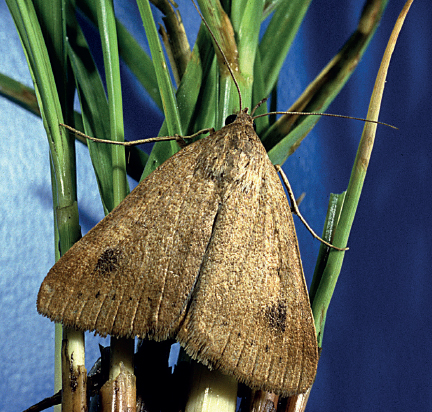
F. Adult of the grass looper. DAVID SHETLAR

G. Fall cankerworm, green form. WHITNEY CRANSHAW
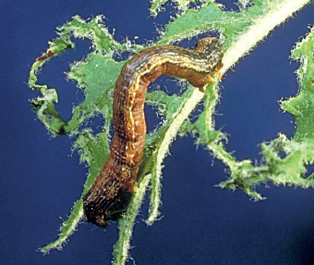
H. Fall cankerworm, dark form. DAVID SHETLAR

I. Mating pair of fall cankerworms. DAVID SHETLAR

J. Fall cankerworm female laying eggs. DAVID SHETLAR

K. Fall cankerworm larva spinning down from tree. DAVID SHETLAR
LIFE HISTORY AND HABITS Most often fall cankerworm winters as eggs in a mass glued to small twigs. Eggs hatch in late April and early May. Young larvae feed on the lower leaf surface and produce skeletonizing wounds. As they get older, they feed in a more general manner and consume all of the leaf except the main veins. When full grown they spin down from the trees, enter the soil, and pupate in a cocoon.
Adults usually emerge after a hard freeze in fall. The flightless females climb the trees and, after mating, lay masses of about 100 eggs in a band around twigs. Occasionally emergence occurs in early spring, particularly in northern areas of the range.
OTHER CANKERWORMS, INCHWORMS, AND SPANWORMS
SPRING CANKERWORM (Paleacrita vernata)1 often occurs in co-infestations with fall cankerworm and shares much of its broad range of host plants. Caterpillars are green to reddish brown, have a single yellowish stripe on each side, and lack the small third pair of prolegs of fall cankerworm. Spring cankerworm adults emerge in late winter, during warm spells in February and March. Females are flightless and climb trunks to lay eggs in masses under bark flakes and in trunk crevices. Peak feeding by larvae occurs in late spring, after which the larvae spin to the ground to pupate.
ELM SPANWORM (Ennomos subsignaria)1 feeds on elm, hickory, ash, oak, basswood, and birch and sometimes appears in large outbreak numbers similar to and coincident with cankerworms. Larvae may vary in color from slate black to light green, with darker forms predominating when populations are high. When full grown they usually pupate in a cocoon attached to the tree. Adults of both sexes are winged and nearly pure white. Females lay eggs in masses on twigs and small branches during midsummer.
LINDEN LOOPER (Erannis tiliaria)1 is a common caterpillar of shade trees throughout much of the northern half of the U.S. and Canada, east of the Rockies. It has a broad host range, including basswood, apple, maple, and oak. Females are wingless and lay eggs in fall, in small clusters under loose bark. One generation is produced per year.
WINTER MOTH (Operophtera brumata)1 is a European species that was separately introduced into both the northwestern states, where it presently occurs in Oregon, Washington, and British Columbia, and the Maritime Provinces, from which it has since spread into large areas of New England. Adults appear over a period of several weeks, from late November through December, and females lay masses of eggs on the trunk and branches of host trees. A wide range of hosts may be used by winter moth, but maple, oak, apple, crabapple, ash, fringetree, and blueberry are most common. Eggs hatch in late March or early April, and the green caterpillars first feed by tunneling into the unopened buds, including the flower buds of blueberries. After buds open the green-colored caterpillars feed more generally on the emerging leaves and can cause extensive defoliation of plants. They become full grown in late May and early June then drop to the soil where they pupate.
BARBERRY LOOPER (Coryphista meadii)1 caterpillars feed on leaves of mahonia and barberry, sometimes seriously defoliating the plants. Winter is spent as a pupa in the ground, and the adults lay eggs in masses of about 100 on twigs in early spring. Larvae first skeletonize leaves and later consume the entire tough leaf except the larger veins. Three generations may be produced during a growing season.
HOLLY LOOPER (Thysanopyga intractata)1 is found in the eastern U.S. wherever its primary host plant, American holly, is present. It is a highly migratory insect, and overwintering populations in the Gulf States may disperse long distances by midsummer. Caterpillars are light green. Typical injury to holly appears as deep notching cuts along the leaf margins.

B. Elm spanworm. TOM MURRAY

C. Linden looper larva. BOB HAMMON, COLORADO STATE UNIVERSITY

D. Linden looper larvae just after egg hatch. BOB HAMMON, COLORADO STATE UNIVERSITY

E. Adult male of the winter moth. ROBERT CHILDS, UNIVERSITY OF MASSACHUSETTS, BUGWOOD.ORG
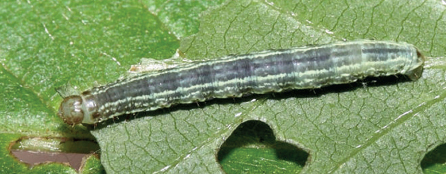
F. Caterpillar of the winter moth. TOM MURRAY

G. Linden looper adult female moth. BOB HAMMON, COLORADO STATE UNIVERSITY

H. Linden looper adult male. BOB HAMMON, COLORADO STATE UNIVERSITY

I. Barberry looper. TOM MURRAY
CURRANT SPANWORM (Speranza ribearia)1 is generally distributed in the northern U.S. and southern Canada, east of the Rockies. Currants and gooseberry (Ribes spp.) are hosts. Larvae first feed on leaf tips and then become general defoliators. They are primarily white with yellow stripes that run along the back and sides. Numerous dark spots are also present, making larvae superficially resemble larvae of the more common currant sawfly. Dull yellow-gray eggs that subsequently overwinter are laid in early summer on branches, usually in the lower canopy.
BRUCE SPANWORM (Operopthtera bruceata)1 occurs throughout southern Canada and the upper midwestern and northeastern states. It develops on a wide variety of shade and forest trees, including sugar maple, aspen, willow, and beech. It sometimes damages blueberry and raspberry as well. Overwintering eggs hatch in early spring, and most larval feeding occurs during May and June. Larvae vary from greenish to dark brown and have three light stripes. They may feed in small groups and sometimes loosely web leaves together as they feed. Pupation occurs in a cocoon around the base of a plant. Adults emerge in fall and mate, and females lay numerous single eggs in various crevices on the plant. Females have rudimentary wings but are incapable of flight.
The SNOWBUSH SPANWORM (Melanchroia chephise) feeds on leaves of snowbush (Breynia nivosa) and a few other plants, including Otaheite gooseberry, white sapote, and snow-on-the-mountain. The caterpillars are brightly colored with black banding. The adult moths have uniformly dark gray wings, tipped with white. This species occurs in the southeastern U.S., from Oklahoma to Florida. OMNIVOROUS LOOPERS (Sabulodes aegrotata, S. caberata)1 are Pacific Coast species that feed on a wide range of trees and shrubs, including acacia, boxelder, California buckeye, chestnut, citrus, elm, eucalyptus, fruit trees, ginkgo, magnolia, maple, pepper tree, and willow. Larvae feed in leaves that they tie together with silk. Early feeding appears primarily as skeletonizing but later becomes more generalized. Pupation also usually occurs in the rolled leaves. As many as five generations may be produced in a year. Bougainvillea is a common host for the BOUGAINVILLEA LOOPER (Disclisioprocta stellata), which occurs in Hawaii, California, and across the southern U.S. Feeding injuries produce a ragged scalloping along leaf edges. Other garden plants that may also be eaten by this insect include amaranthus and four o’clocks.
FILAMENT BEARER (Nematocampa limbata)1 is an eastern species that has a rather bizarre appearance, with long filaments on the second and third abdominal segments. It has a wide host range that includes hemlock and fir as well as various deciduous trees such as maple, oak, pin cherry, buckeye, and apple. HORNED SPANWORM (N. resistaria),1 a minor pest of cranberry in the northeastern U.S., possesses similar fleshy filaments on the abdomen.
Several Lambdina1 species affect shade trees. HEMLOCK LOOPER (L. fiscellaria fiscellaria) is an eastern species that has produced historical forest outbreaks, particularly involving Canada hemlock. Several other trees may also host this insect, including balsam fir and spruce. A subspecies, sometimes known as the “western hemlock looper” (L. fiscellaria lugubrosa) is present from Oregon to Alaska, where western hemlock is the primary host. EASTERN PINE LOOPER (L. pellucidaria) has also occurred in outbreaks among native pines. In the western states, OAK LOOPER (L. vitraria) can be common on oak, particularly Gambel oak. Almost all the Lambdina species overwinter as eggs on trunks and among protective debris. Larval feeding occurs in spring, and one generation is produced annually. On occasion populations may increase dramatically, producing an outbreak, but numerous natural enemies act on these insects so that damaging populations rarely occur in consecutive years.
1 Lepidoptera: Geometridae
A. Bruce spanworm. E. BRADFORD WALKER, VERMONT DEPARTMENT OF FORESTS, PARKS AND RECREATION, BUGWOOD.ORG

B. Snowbush spanworm larvae. DOUG CALDWELL, UNIVERSITY OF FLORIDA

C. Adult of the snowbush spanworm. DOUG CALDWELL, UNIVERSITY OF FLORIDA

D. Bougainvillea loopers. DAVID ROSEN, COURTESY OF UNIVERSITY OF CALIFORNIA STATEWIDE IPM PROGRAM
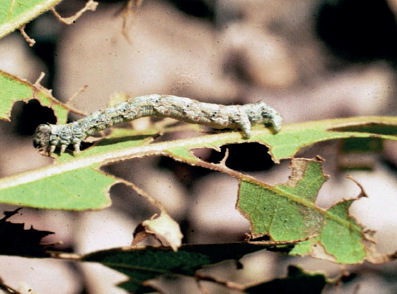
E. Larva and defoliation caused by oak looper. USDA FOREST SERVICE-OGDEN, BUGWOOD.ORG

F. Hemlock looper. CONNECTICUT AGRICULTURAL EXPERIMENT STATION, BUGWOOD.ORG
DIAMONDBACK MOTH (Plutella xylostella)1
HOSTS A wide variety of plants in the mustard family, including cabbage, broccoli, mustard, watercress, and many related weeds.
DAMAGE Caterpillars feed on leaves. Although very small (individual caterpillars consume far less than do the larger cabbage looper or imported cabbageworm), they can be extremely abundant. Diamondback moth has increased in importance because of its ability to develop resistance to many commonly used insecticides.
DISTRIBUTION Throughout North America.
APPEARANCE Larvae are small caterpillars, less than ½ inch when full grown, and are pale green with the hind pair of prolegs conspicuously protruding. Larvae wriggle vigorously and drop from plants when disturbed. Adults have generally gray wings which, when folded over the body, show a series of white diamond patterns on the back.
LIFE HISTORY AND HABITS In northern areas, diamondback moths winter as pupae, with adults emerging and becoming active in early spring. In southern areas, development may be continuous. Eggs are laid singly or in small groups on leaves of various mustard family plants. Young larvae typically feed on the underside of leaves and produce windowpane injuries. Older larvae feed more generally. Pupation occurs in a loose cocoon, usually attached to outer leaves. Three to four generations are typically produced annually in northern areas, with more than a dozen possible in the south.
1 Lepidoptera: Plutellidae
SKELETONIZERS
The term “skeletonizer” is broadly applied to caterpillars of several moth families that feed between veins of leaves, producing skeletonized appearance though there are beetles and sawflies that skeletonize leaves. APPLE AND THORN SKELETONIZER (Choreutis pariana)1 is common in much of the northern U.S. and southern Canada, sometimes occurring in populations that fluctuate greatly in abundance between seasons. It is associated primarily with fruit trees but has a wide host range that includes crabapple, apple, birch, cherry, hawthorn, willow, and mountain-ash. The overwintering moths lay eggs shortly after bud break. Larvae first feed on the underside of leaves under a covering of silk. They later migrate to the upper leaf surface and construct a new shelter by tying adjacent leaves together. During the warm season, the life cycle can be completed in a month, and up to four generations per year can be produced.
OAK RIBBED SKELETONIZER (Bucculatrix albertiella)2 occurs in the Pacific States. Young larvae feed as leafminers of oak leaves. As they get older, they skeletonize the surface. They produce characteristic cocoons that are strongly ribbed. Two generations are produced in Washington. OAK SKELETONIZER (B. ainsliella) is particularly common around the Great Lakes but ranges from New England to Mississippi. It feeds on oak and chestnut. Adults appear in late May and lay eggs on leaves. Initial feeding occurs as small mines, and later feeding skeletonizes the underside of leaves. Small patches of webbing are produced whenever oak skeletonizers molt, and they also pupate in white, ribbed cocoons.
A. Diamondback moth. DAVID CAPPAERT, BUGWOOD.ORG
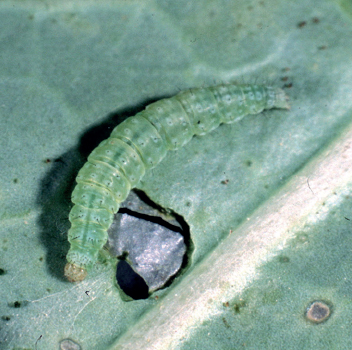
B. Diamondback moth caterpillar. ALTON N. SPARKS JR., UNIVERSITY OF GEORGIA, BUGWOOD.ORG

C. Diamondback moth injury to broccoli. WHITNEY CRANSHAW

D. Diamondback moth pupa, within a loose cocoon. WHITNEY CRANSHAW

E. Damage by apple and thorn skeletonizer. ROBIN ROSETTA, OREGON STATE UNIVERSITY

F. Apple and thorn skeletonizer. ERIC LAGASA, WASHINGTON STATE DEPARTMENT OF AGRICULTURE, BUGWOOD.ORG

G. Adult of the oak skeletonizer. DAVID SHETLAR

H. Damage by oak skeletonizer. DAVID SHETLAR

I. Pupae of the oak skeletonizer. JAMES SOLOMON, USDA-FOREST SERVICE, BUGWOOD.ORG

J. Oak skeletonizer caterpillar. G. KEITH DOUCE, UNIVERSITY OF GEORGIA, BUGWOOD.ORG
BIRCH SKELETONIZER (Bucculatrix canadensisella) feeds on birch, particularly paper birch. It pupates off the tree, spinning down when full grown and producing a dark cocoon in leaf litter and other debris. APPLE BUCCULATRIX (B. pomifoliella) occurs in the northeastern U.S. and southeastern Canada, where it feeds on hawthorn, apple, black cherry, and serviceberry. HOLLYHOCK LEAF SKELETONIZER (B. thurnberiella) skeletonizes hollyhock and malva in California.
WESTERN GRAPELEAF SKELETONIZER (Harrisina metallica)3 is found west of the Rockies, where it develops on wild and cultivated grapes, Virginia creeper, and Boston ivy. Some fruit trees are occasionally infested. Adults are unusual bluish black or greenish black moths with a wingspan over 1 inch; they first emerge from late April through mid-May. Females lay eggs in clustered groups on the underside of leaves, usually in shaded areas of the vines. The larvae feed together, often side by side, during most of their development, skeletonizing leaves from the underside. As the larvae get older, extensive defoliation can rapidly occur. The larvae are strikingly colored insects with brightly colored bands of yellow, white, blue, and black across the body. They are also covered with moderate-sized hairs that can be very irritating to people who are sensitive to them. In central California three generations are produced annually. Winter is spent as a pupa in a cocoon, often attached to loose bark of the vines.
In the eastern states, GRAPELEAF SKELETONIZER (H. americana) is present and similarly feeds on grape and Virginia creeper. Most of its habits parallel those of western grapeleaf skeletonizer. Larvae are yellowish with black banding and usually feed gregariously, although late-stage larvae chew holes in leaves. One generation is typically completed, sometimes a second.
Pryeria sinica (“euonymus leaf notcher”)3 is a newly established species in Virginia and Maryland, with expanding range, that develops on leaves of Euonymus and Celastrus. Young larvae feed as a group and skeletonize but later disperse throughout the plant and cause more generalized defoliation, particularly around leaf edges. Injury occurs in April and May and there is one generation per year.
PALM LEAF SKELETONIZER (Homaledra sabalella)4 is an insect native to Florida and areas of the Carribean, which develops on sabal palmettos and occasionally palms, including coconut. The caterpillars feed gregariously, primarily on lower leaf surface, and create a silken tube that becomes mixed with their excreted frass.
Larvae of MAPLE TRUMPET SKELETONIZER (Calastega aceriella)5 make unusual trumpetlike tubes of silk and incorporate frass that covers their bodies. Adults lay eggs on leaves of sugar and red maples in June and early July, and the larvae develop as skeletonizers feeding between veins of loosely folded leaves. They drop to the ground later in the summer when full grown and pupate in a cocoon. One generation is produced. Maple trumpet skeletonizer occurs in the northeastern U.S. and southeastern Canada.
1 Lepidoptera: Choreutidae
2 Lepidoptera: Bucculatricidae
3 Lepidoptera: Zygaenidae
4 Lepidoptera: Pterolonchidae
5 Lepidoptera: Tortricidae

B. Damage produced by birch skeletonizer. DAVID SHETLAR

C. Grapeleaf skeletonizer larvae. JIM KALISCH, UNIVERSITY OF NEBRASKA

D. Western grapeleaf skeletonizer larvae. HAROLD LARSEN, COLORADO STATE UNIVERSITY

E. Adult of the grapeleaf skeletonizer. DAVID CAPPAERT, BUGWOOD.ORG

F. Late-instar larvae of the euonymus leaf notcher. ERIC DAY, VIRGINIA POLYTECHNIC AND STATE UNIVERSITY, BUGWOOD.ORG

G Skeletonizing damage by young larvae of the euonymus leaf notcher. ERIC DAY, VIRGINIA POLYTECHNIC AND STATE UNIVERSITY, BUGWOOD.ORG
Bagworms (Psychidae) are unusual caterpillars that develop in a silken case covered with leaf fragments or other debris. Adult females are wingless moths that remain in the case. Adult males, if they are produced, are winged. The term “casebearer” is generally applied to larvae of small moths (Coleophoridae) that produce a parchmentlike case that the caterpillar carries throughout development; however, some other types of caterpillars construct protective cases of silk that in-corporate leaf material and/or frass. Case making, with incorporated frass, also occurs with the larvae of leaf beetles in the genera Neochlamisus and Exema (page 182).
BAGWORM (Thyridopteryx ephemeraeformis)1
HOSTS Juniper, cedar, false cypress, and arborvitae are most commonly infested. Bagworm may feed on a wide variety of other woody plants including black locust, elm, pine, cabbage palmetto, honeylocust, buckeye, sycamore, and willow.
DAMAGE Caterpillars chew foliage and during outbreaks can seriously defoliate plants. Swellings on twigs sometimes occur around the site where bags were attached for pupation.
DISTRIBUTION Generally in the eastern U.S. from southern New England to parts of Nebraska and south to Texas and Florida.
APPEARANCE Bagworm is a bizarre caterpillar that develops in a silken bag with bits of interwoven twigs and foliage. When full sized, the bag may be 1½ to 2 inches long. Females remain in the bag through all life stages. Males emerge from the bag and are black, daytime-flying moths that resemble small bumble bees with clear wings that span about 1 inch.
LIFE HISTORY AND HABITS Bagworm winters as eggs in the bag of the mother. In most areas eggs remain dormant until late spring, at which time the larvae emerge and disperse, often ballooning on strands of silk. They begin to feed and construct the case almost immediately, first being found on the upper leaf surface, where they feed on surface tissues. Later they migrate to the underside of leaves and feed more generally, expanding the bag as they grow. When full grown they pupate in late summer. Winged males fly in September to mate with females that remain in their bags. One generation is produced annually in most areas; bagworm may reproduce continually in parts of Florida.

B. Female bagworm exposed within case. DAVID SHETLAR

C. Female bagworm, exposed within case and dissected to show egg. DAVID SHETLAR

D. Bagworm larvae leaving case after egg hatch. DAVID SHETLAR

E. Young bagworm, within case. DAVID SHETLAR

F. Bagworm adult male, mating with female in bag. DAVID SHETLAR
In the southern states, ranging from Virginia to Texas, ABBOT’S BAGWORM (Oiketicus abbotii)1 is also present. It feeds on a variety of commonly grown shrubs, including pyracantha, arborvitae, rose, sugarberry, avocado, mesquite, and giant leadtree. It makes a larger and more distinctive bag than does the bagworm.
GRASS BAGWORM (Psyche casta)1 produces a case in the form of a small bundle of grass pieces that is usually noticed when attached to a fence post, building siding, or tree trunk. The cases are constructed of silk with ½- to 1-inch pieces of grass blades attached. The small caterpillars that make these cases do so in the spring and reach maturity by mid-May. The bags are very well hidden in the grass as the pieces are first green, but they turn brown over time. When mature, the caterpillars in their bags crawl up a permanent surface and attach the bag to it. By mid-June, tiny male gray moths emerge. These seek out the non-winged female bags and mate. After mating, the female deposits her eggs within the bag. The caterpillars feed on a wide variety of plants including grasses, lichens, mosses, and other low-growing plants.
SNAILCASE BAGWORM (Apterona helix),1 sometimes known as garden bagworm, is an odd insect that constructs a coiled case of silk covered with particles of soil and excrement. Larvae have a wide host range that includes broccoli, bean, squash, gypsophila, violet, alfalfa, vetch, rose, apple, pear, ponderosa pine, and Douglas-fir. Snailcase bagworm is found in localized areas throughout the western states and has become established in parts of New York, Pennsylvania, Massachusetts, and Michigan. The introduced insect is easily spread by humans and can be expected to increase its range.
Winter is spent as a young larva in the case of the mother bagworm. Larvae emerge in spring to complete development, producing the typical case they carry and remain in throughout life. As they feed, larvae often chew the leaf interior, similar to a leafminer but with the bag remaining on the outside. Injuries result from windowpaning or from skeletonizing. Mature larvae have a migratory habit and move to a vertical surface where they fasten firmly for pupation. Adult females emerge in the case in August and lay eggs. Males are unknown for this species.
Two European species of bagworms that feed on lichen and algae are present in some areas of eastern North America, Dahlica triquetrella1 and D. lichenella. Neither is damaging to garden plants, but their cases may attract interest when seen attached to rocks, walls, and other sites where lichen are present. Bits of their food plants and small pieces of soil are often incorporated into the larval cases.
1 Lepidoptera: Psychidae

B. Grass bagworm, adult male. DAVID SHETLAR

C. Snailcase bagworms. WHITNEY CRANSHAW

D. Snailcase bagworms feeding on Canada thistle. WHITNEY CRANSHAW

E. Snailcase bagworm crawling up wall. WHITNEY CRANSHAW

F. Snailcase bagworms settled for pupation under eaves of a barn. WHITNEY CRANSHAW
PISTOL CASEBEARER (Coleophora malivorella)1 is widespread east of the Rocky Mountains and feeds on leaves and buds of most tree fruits, especially apple, pear, and cherry. Larvae feed and destroy leaf and flower buds early in the season. Later they make shallow mines as they feed on maturing fruit and leaves.
Winter is spent as a partially grown larva in the case, which is dirty gray-brown. Larvae move to buds with warm days in spring, and as they grow they continue to enlarge the case with silk mixed with leaf fragments and excrement. The case becomes curved in later stages, somewhat resembling a pistol. Around mid-June the larvae secure the cases to twigs or leaves and pupate.
After about 2 weeks, adult moths emerge and lay eggs within a few days of emergence. Eggs are laid on the upper side of leaves. After egg hatch, larvae tunnel to the underside of leaves, form new silk cases, feed until fall, and secure themselves to twigs for winter.
CIGAR CASEBEARER (Coleophora serratella)1 has a similar life history and overlaps both in its range of hosts and in distribution. Larvae are dark orange with a black head and produce a cigar-shaped case of leaf fragments. Adults are small steel-gray moths with fringed wings and are present in early summer. ELM CASEBEARER (C. ulmifoliella)1 is an eastern U.S. species that makes a small case by folding and cutting the edge of an elm leaf. From within these cases, the larvae mine brown patches between leaf veins of American, red, and slippery elm. PECAN CIGAR CASEBEARER (C. laticornella) causes similar injury to pecan. The first generation of PECAN LEAF CASEBEARER (Acrobasis juglandis)2 also damages early-season growth of pecan. Later generations cause little damage to host trees. Older larvae live in grayish, trumpet-shaped cases attached to the undersides of leaflets.
LARCH CASEBEARER (Coleophora laricella)1 is an introduced species that now occurs throughout the range of native larch and occurs as a pest where larch is used in landscape plantings. Peak injury is caused shortly after bud break when the overwintered larvae resume feeding. They mine individual needles, as deeply as their bodies can extend beyond the case they carry. They become full grown and pupate by late spring in the case constructed of silk and portions of damaged needles. Adults lay eggs in late spring and early summer. Early-stage larvae feed through the summer as needleminers and then create a case in which they winter. The case is located at the base of larch buds and resembles dead needles.
1 Lepidoptera: Coleophoridae
2 Lepidoptera: Pyralidae

B. Elm casebearer. DAVID SHETLAR

C. Pecan cigar casebearer. H. C. ELLIS, UNIVERSITY OF GEORGIA, BUGWOOD.ORG
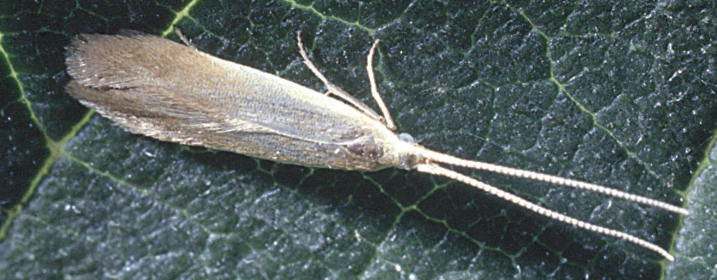
D. Adult of the elm casebearer. DAVID SHETLAR

E. Casebearer pupating on wall. WHITNEY CRANSHAW

F. Larch casebearer. DAVID SHETLAR

G. Adult larch casebearer. DAVID SHETLAR

H. Larch casebearer. DAVID SHETLAR

I. Pecan leaf casebearer. JERRY A. PAYNE, USDA AGRICULTURAL RESEARCH SERVICE, BUGWOOD.ORG
CATERPILLARS THAT PRODUCE CASES OF LEAF FRAGMENTS
MAPLE LEAFCUTTER (Paraclemensia acerifoliella)1 feeds on maple in the northeastern U.S. and southern Canada. Early larvae initiate feeding as leafminers, shortly after new leaves have emerged. Older larvae move outside and fashion a case out of round fragments cut from leaves. When feeding, the larva attaches the case to the leaf surface and feeds as far as it can reach, producing circular holes in the leaves. Feeding is usually completed by late spring, and the larva drops to the ground to pupate and overwinter.

Maple leafcutter larva exposed from leaf shelter. RONALD S. KELLEY, VERMONT DEPARTMENT OF FORESTS, PARKS AND RECREATION, BUGWOOD.ORG
LEAF CRUMPLER (Acrobasis indigenella)2 produces a silken shelter tube attached to twigs. The caterpillars feed on leaves of a wide variety of rosaceous plants, including hedge cotoneaster, crabapple, pyracantha, hawthorn, and pear. It occurs in most of North America east of the Mississippi River and in California. Winter is spent as a partially grown larva in the case. Larvae resume feeding in spring and may leave their cases to feed at night, returning with leaf fragments. Pupation occurs in May, and adults lay eggs on leaves a few weeks later, producing a summer generation that is usually most damaging. In most areas two generations are annually produced, but only one may occur in more northern areas.
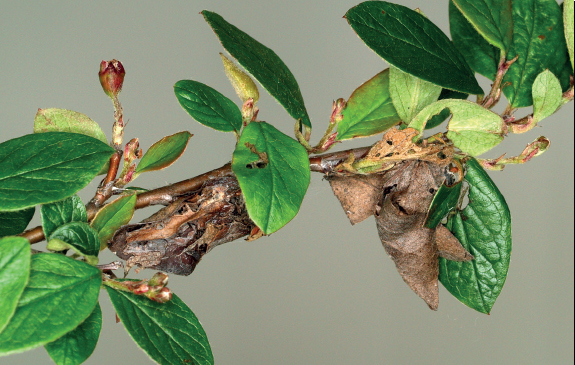
Injury by leaf crumpler caterpillar. JIM KALISCH, UNIVERSITY OF NEBRASKA
CHINA MARK MOTH (Nymphuliella daeckealis)3 develops on waterlily (Nymphoides, Nymphaea) and is one of several caterpillars adapted to living on aquatic plants. Winter is spent as a partially developed caterpillar within a shelter attached to the stems of plants. In spring when water warms they move to the surface and resume feeding, producing skeletonizing injuries.
At all times the larvae live within pieces of cut leaves, a habit leading to the common name “sandwich-man caterpillar.” New pieces are cut as the caterpillars grow, giving waterlily leaves a ragged appearance. These leaf shelters also float, allowing the caterpillars to move among plants.
Pupation occurs within the cut leaf shelter and adults subsequently emerge. The insect gets its name from the features of the adult moth, which has white forewings marked with dark gray. Eggs are laid on the surface of leaves. Three generations a year are normally completed in Maryland.
WATERLILY LEAFCUTTER (Elophila obliteralis)3 also cuts leaves to construct a shelter and feeds on several aquatic plants, including waterlily, pondweed, and duckweed. Although damage to plants is usually minor, it has been found to significantly damage Hygrophila, an important invasive aquatic weed in Florida.
1 Lepidoptera: Incurvariidae
2 Lepidoptera: Pyralidae
3 Lepidoptera: Crambidae
A. Maple leafcutter injury. RONALD S. KELLEY, VERMONT DEPARTMENT OF FORESTS, PARKS AND RECREATION, BUGWOOD.ORG

B. Leaf crumpler caterpillar in its case. JIM KALISCH, UNIVERSITY OF NEBRASKA

C. Leaf crumpler showing long tube case it produces. JIM KALISCH, UNIVERSITY OF NEBRASKA

D. Adult of the leaf crumpler. JIM KALISCH, UNIVERSITY OF NEBRASKA

E. Leaf shelter produced by larva of the China mark moth. STANTON GILL, UNIVERSITY OF MARYLAND

F. Larva of the China mark moth. STANTON GILL, UNIVERSITY OF MARYLAND

G. Adult of the waterlily leafcutter. USDA-ARS, BUGWOOD.ORG
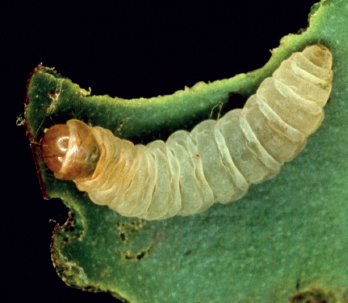
H. Waterlily leafcutter. USDA-ARS, BUGWOOD.ORG
CATERPILLARS THAT PRODUCE SMALL SILKEN SHELTERS
Several types of caterpillars use silk to create small shelters among the foliage on which they are feeding. These are often described as being some type of leafroller, leaftier, or webworm and most occur in the families Tortricidae, Crambidae, and Hesperiidae. In general, the term “leafroller” is used for insects that roll the edge of a leaf, and leaftiers web together two or more leaves to produce a shelter. However, these common names are fairly loosely used and may also be applied to insects with habits that combine both behaviors as well as some caterpillars that create a portable leaf case (discussed above). The use of the term “webworm” is even less consistently used and is applied to insects that make discrete silken tube shelters, others that loosely web leaves together, and some that feed in groups and create large silken tents.
SOD WEBWORMS
Sod webworm is a general description of a family of caterpillars (Crambidae) that develop exclusively or primarily on grasses and sedges. Larvae of most species produce a silk-lined tube at the base of the plants in which they live. Adults are often described as “lawn moths,” although there are other types of moths that are sometimes common on lawns. A few species (e.g., cranberry girdler) have a subterranean feeding habit and are discussed in chapter 6, insects associated with roots.
A typical species found associated with turfgrasses that is widely distributed in the northern U.S. and southern Canada is the LARGER SOD WEBWORM (Pediasia trisecta).1 Larvae develop primarily on bluegrass, but bentgrass, ryegrass, and fescues may be eaten. Early-stage larvae locate within the leaf fold at the base of the plant and feed on the leaf surface. As they get older, they move to the base of the plant and form a silken tube used as a retreat. They emerge at night and clip grass blades that are dragged back to the shelter and consumed. In high populations, the feeding injuries may produce turfgrass areas that appear thin and have a ragged appearance. The silk tunnel often fills with fecal droppings (frass) and leaf fragments, forcing the larvae to initiate a new tunnel.
Larval development following egg hatch may take 30–50 days to complete, after which a cocoon is formed in which to pupate. Adults are snout moths with a wingspan of about 1 inch; at rest the wings are slightly folded over the body, giving the moth a tubular body form. During the day they rest on vegetation and become active at dusk. During egg laying the females fly low over the plants, scattering eggs while in flight.
Winter is spent in the form of a partially developed larva, protected within a silken shelter, that resumes feeding in early spring. The number of generations produced by P. trisecta varies by location, with three generations reported from New Jersey and Virginia, and only a single generation noted in Washington.
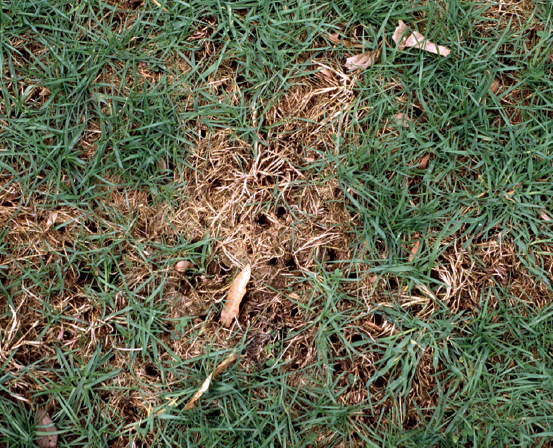
B. Damage produced by sod webworm. DAVID SHETLAR

C. Adult of the larger sod webworm. DAVID SHETLAR

D. Sod webworm larva. DAVID SHETLAR

E. Life stages of a sod webworm. DAVID SHETLAR
About twenty species of sod webworms have been reported to develop in lawns. Most have feeding habits generally similar to those of the larger sod webworm, although there may be differences in the number of generations produced and periods of peak larval activity. Among those developing on cool-season turfgrasses (bluegrasses, ryegrasses, bentgrasses) are: WESTERN LAWN MOTH (Tehama bonifatella), BLUEGRASS WEBWORM (Parapediasia teterrella), STRIPED SOD WEBWORM (Fissicrambus mutabilis), ELEGANT SOD WEBWORM (Microcrambus elegans), VAGABOND CRAMBUS (Agriphila vulgivagella), LESSER VAGABOND CRAMBUS (Agriphila ruricolella), YELLOW CRAMBUS (Neodactria luteolellus), CORN ROOT WEBWORM (N. caliginosellus), LEACH’S CRAMBUS (Crambus leachellus), SPERRY’S LAWN MOTH (C. sperryellus), SILVER-STRIPED WEBWORM (C. praefectellus), and Thaumatopsis pexellus.1
The most serious sod webworm pest of warm-season turfgrasses in the southern U.S. is TROPICAL SOD WEBWORM (Herpetogramma phaeopteralis), which develops year-round on St. Augustinegrass, bermudagrass, and centipedegrass. Peak injury occurs in fall.

Tropical sod webworm larva. DAVID SHETLAR

Tropical sod webworm larva. DAVID SHETLAR
Larvae of the SNOWY UROLA MOTH (Urola nivalis)1 also develop on grasses, but the adult is somewhat larger and considerably more showy than are most sod webworms. The snowy urola moth can be found over a broad area of the eastern U.S., ranging into parts of Texas and Arizona.
Adults of LUCERNE WEBWORM (Nomophila nearctica)1 can be seen very commonly on lawns and low-growing plants. The moths are somewhat larger than sod webworms, with brown wings marked with darker brown streaks and veins. The larvae feed on many types of low-growing plants, including grasses, clovers, sweetclovers, dichondra, and prostrate knotweed.
1 Lepidoptera: Crambidae

B. Adult of the vagabond crambus. DAVID SHETLAR

C. Adult of the tropical sod webworm. DAVID SHETLAR

D. Adult of the snowy urola. DAVID SHETLAR
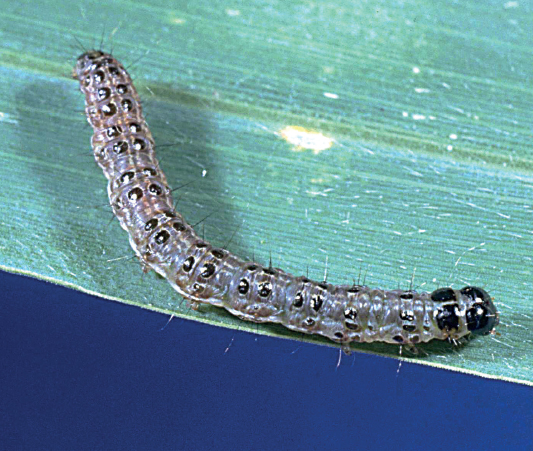
E. Lucerne webworm. DAVID SHETLAR

F. Adult of the Lucerne webworm. DAVID SHETLAR
Two closely related species sometimes damaging to gardens are ALFALFA WEBWORM (Loxostege cerealis)1 and BEET WEBWORM (L. sticticalis). Caterpillars are about ¾ inch when full grown. They are green or yellowish green when young but darken as they get older. Larvae are found in silken tunnels spun among the foliage and wriggle vigorously when disturbed. These insects may occur on a wide range of garden vegetables, including cabbage, beet, carrot, lettuce, and cucumber. They also occur on several weeds, including lambsquarter, pigweed, and dock. Both species are found primarily in western North America.
Alfalfa and beet webworms winter as mature larvae in soil. Adults are active in spring and lay eggs in a small mass that looks somewhat like overlapping fish scales. The newly hatched caterpillars make a small silk pad and skeletonize the leaf surface. Older larvae more extensively web together foliage and produce a silken tube where they rest and from which they emerge to feed. Pupation occurs in the upper soil in a silk-lined cell. Two to four generations may occur per year, depending on temperature and location.
GARDEN WEBWORM (Achyra rantalis)1 can be found in the eastern U.S. and parts of California but is primarily damaging in the southern High Plains. It shares many habits with beet and alfalfa webworms and also produces webbing of leaves tied together to form a loose shelter. Young larvae skeletonize, and older stages feed more generally on leaves. Larvae are generally yellow-green with prominent dark spots and a yellowish head. Beans and peas are common hosts.
CELERY LEAFTIER (Udea rubigalis),1 also known as GREENHOUSE LEAFTIER, is broadly distributed in North America and occurs as both a greenhouse and garden pest. Beets, lettuce, and celery are the most common vegetable hosts. Ornamental plants on which they feed include chrysanthemum, petunia, geranium, coleus, azalea, and begonia. The caterpillars feed on the leaves, silking them together in a manner similar to that of other “garden webworms.” Mature caterpillars are pale green with a narrow, darker green band along the back and whitish bands along each side. Generations can be completed in from 1 to 3 months, depending on temperature. In the northern half of California and the Pacific States, the closely related FALSE CELERY LEAFTIER (U. profundalis) is present and sometimes similarly damaging.
CABBAGE WEBWORM (Hellula rogatalis)1 is found throughout the southern U.S., occasionally dispersing into northern states. Larvae develop on cabbage and related crucifers and cause the most damage when older larvae web leaves together that they chew, damaging the growing point. Younger caterpillars act as leafminers and may tunnel main veins, causing tip dieback. Cabbage webworm is yellowish gray with a dark head and usually found in the loose webbing it produces.
CROSS-STRIPED CABBAGEWORM (Evergestis rimosalis)1 is an occasional pest of collards, Brussels sprouts, and related vegetable plants. It can be found over much of the eastern U.S. but is common only in some of the southeastern states. Caterpillars have a distinctive patterning of thin black and white striping on the back and prominent yellow lines on the sides. Several generations are produced annually; in southern areas, the species can often be active and damaging by early spring. A related species, PURPLEBACKED CABBAGEWORM (E. pallidata), is a species of more northern distribution, ranging into eastern Canada. Larvae feed on cabbage family plants and the mature caterpillars are olive green or purple-brown.
1 Lepidoptera: Crambidae

B. Alfalfa webworm eggs. JOHN CAPINERA, UNIVERSITY OF FLORIDA

C. Alfalfa webworm. FRANK PEAIRS, COLORADO STATE UNIVERSITY

D. Adult alfalfa webworm. WHITNEY CRANSHAW

E. Garden webworm. ALTON N. SPARKS JR., UNIVERSITY OF GEORGIA, BUGWOOD.ORG

F. Adult of the garden webworm. DAVID SHETLAR

G. Cross-striped cabbageworms. DAVID SHETLAR
FRUITTREE LEAFROLLER (Archips argyrospila)1
HOSTS A wide variety of deciduous trees and shrubs, including apple, crabapple, honeylocust, ash, and linden.
DAMAGE Larvae first fold over a leaf and chew it, producing skeletonized patches. Older larvae tie together several leaves with silk and their feeding produces a ragged appearance. On fruit trees, incidental feeding on young fruit may occur, inducing fruit abortion or distortion (catfacing).
DISTRIBUTION Throughout most of North America.
APPEARANCE Larvae are green with a black head and found in the folded or tied leaves. When disturbed they wriggle vigorously and may escape the shelter by dropping down on a strand of silk. Adults have rusty brown wings with silvery or pale gold patches. Wingspan is about ¾ inch.
LIFE HISTORY AND HABITS Fruittree leafroller spends winter in the egg stage. Eggs are laid in a flat gray-brown mass, typically containing more than 100 eggs, glued to twigs. Egg hatch occurs in early spring shortly after leaves emerge. Young larvae usually feed first around the tips and emerging leaves. Older larvae begin to tie up leaves with webbing and feed inside this shelter. When mature, larvae usually pupate in the rolled leaves but may disperse to bark cracks of the trunk and large branches. Adult moths appear 2 weeks later, mate, and lay the overwintering egg masses. There is one generation per year.
OTHER LEAFROLLERS, LEAFFOLDERS, AND LEAFTIERS
BOXELDER LEAFROLLER (Archips negundana)1 is found throughout most of the northern half of the U.S. and Canada, feeding on leaves of boxelder and, less commonly, honeysuckle and alder. ROSE TORTRIX (A. rosana), sometimes known as “filbert leafroller,” develops on filbert, apple, pear, hawthorn, cherry, currant, and privet in the northwestern U.S. and western Canada. The life histories of these other Archips species are similar to that of fruittree leafroller. OAK LEAFROLLER (A. semiferana) is primarily associated with red oaks in eastern North America and Gambel oak in the Rocky Mountain region. Late-stage larvae often roll leaves but may tie leaves together and produce visible webbing during outbreaks where significant defoliation occurs. Several other caterpillars tie together leaves of oaks, notably the OAK WEBWORM (A. fervida) and OAK LEAFTIER (Acleris semipurpurana).1

Injury produced by boxelder leafroller. USDA FOREST SERVICE–OGDEN, BUGWOOD.ORG

Oak leaftier injury. DAVID SHETLAR
A. Leaf tying and feeding on terminal leaves by fruittree leafroller. KEN GRAY COLLECTION, REGON STATE UNIVERSITY

B. Fruittree leafroller larva. JEFF HAHN, UNIVERSITY OF MINNESOTA

C. Adult fruittree leafroller next to pupal skin. JIM KALISCH, UNIVERSITY OF NEBRASKA

D. Egg mass of the fruittree leafroller. JACK KELLY CLARK, COURTESY OF UNIVERSITY OF CALIFORNIA STATEWIDE IPM PROGRAM

E. Oak leafroller larva and pupa. WILLIAM M. CIESLA, FOREST HEALTH MANAGEMENT INTERNATIONAL, BUGWOOD.ORG

F. Oak leafroller adult. WILLIAM M. CIESLA, FOREST HEALTH MANAGEMENT INTERNATIONAL, BUGWOOD.ORG
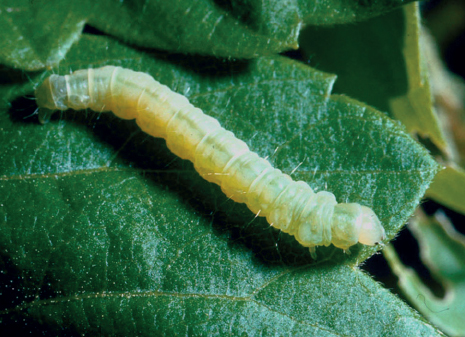
G. Boxelder leafroller larva. BILL KLEIN, USDA FOREST SERVICE, BUGWOOD.ORG
In Louisiana and Mississippi, overwintered eggs of BALDCYPRESS LEAFROLLER (Archips goyerana) hatch at bud break and the young initially feed within the cluster of emerging needles. Older larvae tie together needles and complete their development within this shelter. BALDCYPRESS WEBWORM (Coleotechnites apicitripunctella)2 develops as a needleminer of hemlock and baldcypress. The mined needles are webbed together into a small mat and the larvae spend winter within this shelter. It occurs in the midwestern and northeastern U.S. and parts of southeastern Canada. Mined needles of spruce are tied together in a similar manner by SPRUCE NEEDLEMINER (Taniva albolineana).4
EYESPOTTED BUD MOTH (Spilonota ocellana)1 is a pest of tree fruits and caneberries in the Pacific States and British Columbia. Winter is spent as a young larva within a cocoon attached to the bark (hibernaculum). Larvae emerge and begin to feed around bud break in spring, damaging newly opening buds and leaves. They may also tunnel in shoots of apple or cherry, causing twig dieback. By late spring they complete development, usually pupating on the plant. Eggs are laid during midsummer, and larvae active at this time feed on leaves, typically cutting them and rolling them together, fastened with silken thread. Fruit damage occurs when leaves of feeding shelters include fruit, which may then be scarred by feeding larvae.

Eyespotted budworm larva. THE KEN GRAY COLLECTION, OREGON STATE UNIVERSITY

Mined needles and associated webbing produced by several spruce needleminers. WHITNEY CRANSHAW
OBLIQUEBANDED LEAFROLLER (Choristoneura rosaceana)1 is one of the most common leafrollers, found throughout most of North America except in arid areas of the southwestern U.S. It has an extremely wide host range but feeds primarily on azalea and various rosaceous plants, including fruit trees. Damage begins earlier than with some other leafrollers, as winter is spent as a partially grown larva in a protected cocoon (hibernaculum) on the bark, from which it emerges and tunnels into buds during spring. Developing fruit may also be damaged at this time. First-generation adults are present in late spring, and eggs are laid as masses on leaves during June. The summer generation is completed by August. LARGE ASPEN TORTRIX (C. conflictana) is a forest species that feeds on aspen leaves. Larvae may roll the edge of a single leaf or tie together two leaves to produce a feeding shelter.

Larva of the large aspen tortrix. DAVID SHETLAR
A. Baldcypress webworm. CONNECTICUT AGRICULTURAL EXPERIMENT STATION, BUGWOOD.ORG

B. Injury produced by baldcypress webworm. DAVID SHETLAR
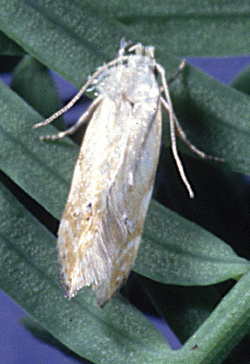
C. Adult baldcypress webworm. DAVID SHETLAR
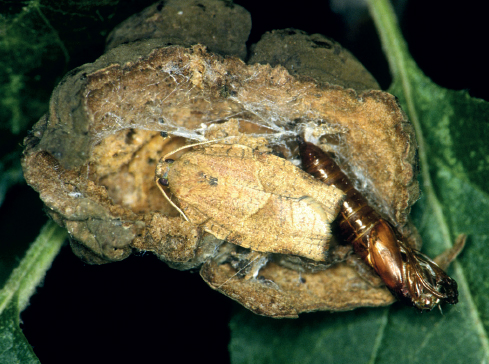
D. Adult and pupal skin of the obliquebanded leafroller. JIM KALISCH, UNIVERSITY OF NEBRASKA

E. Obliquebanded leafroller. TODD M. GILLIGAN AND MARC E. EPSTEIN, USDA ITP, BUGWOOD.ORG

F. Adult obliquebanded leafroller. WHITNEY CRANSHAW

G. Leafrolling produced by large aspen tortrix. STEVEN KATOVICH, USDA FOREST SERVICE, BUGWOOD.ORG

H. Egg mass of the large aspen tortrix. STEVEN KATOVICH, USDA FOREST SERVICE, BUGWOOD.ORG
LIGHT BROWN APPLE MOTH (Epiphyas postvittana)1 is a species native to Australia that has recently become established in California. It is a generalist in feeding habits, capable of developing on a very wide variety of hosts; however, it is still unclear how serious a pest this will develop into in North America. In Hawaii, where it was earlier introduced, feeding injury is seen to occur largely on noncrop plants, some of which are considered invasive weeds.
REDBANDED LEAFROLLER (Argyotaenia velutinana)1 is an occasional pest of apple orchards in the northeastern and midwestern states. Both the body and head of larvae are uniformly colored green to pale yellow. The larvae live in a loose silken shelter they spin on leaves and among buds and emerging growth. Leaf-feeding injuries are insignificant, but serious fruit injury is caused when developing fruit is incorporated into the webbing and chewed. Young fruits on which first-generation larvae feed often abort or develop deep gouging wounds. Injuries inflicted by the summer generation produce more superficial fruit scarring. ORANGE TORTRIX (A. citrana) is a western species that ties together and feeds on the leaves of tree fruits, citrus, willow, oak, goldenrod, geranium, begonia, black walnut, and many other plants. It usually does little damage, but citrus might be damaged when larvae incidentally chew into the peel of fruit tied among the leaves of the feeding shelter. A minor but commonly observed pest of eastern white pine is PINE TUBE MOTH (A. pinatubana), which forms shelters of 5–20 needles tied together with silk into a tube. It chews the needles until they are about 1 inch long and then abandons the shelter to form a new one. Two generations occur per year in Pennsylvania, with adults emerging in early to mid-April and the second-generation adults present in July.
BLACKHEADED FIREWORM (Rhopobota naevana),1 sometimes known as HOLLY BUD MOTH, is a common insect in much of North America. Young larvae of the first generation feed on the opening buds of apple, cherry, blueberry, holly, and other woody ornamentals. Later stages act as leafrollers, tying together leaves in which they feed. Two generations occur, with moths from the second generation present in June in North Carolina. The wintering stage consists of eggs laid on the host plant.
CHERRY BARK TORTRIX (Enarmonia formosana)1 may develop on most tree fruits and is presently found in parts of Washington and British Columbia. Larvae feed primarily on bark, causing some injuries to underlying cambium. Bark is loosened from these activities and may allow development of cankers. Older stone fruits (Prunus spp.) with preexisting wounds are most commonly attacked.
Several leafrollers in the genus Platynota1 are minor pests of fruit crops in most areas of the U.S. In the eastern states, VARIEGATED LEAFROLLER (P. flavedana) is occasionally damaging to strawberry and apples when larvae incidentally chew young fruit that is incorporated along with the leaves they silk together. The host range is fairly wide and also includes rose, peach, azalea, begonia, and helianthus, although leaf-feeding injuries are minor. Variegated leafroller has two generations in the Midwest, with peak egg-laying in June and again in late August in Michigan. Winter is spent as a partially grown larva at the base of plants, and some spring feeding on low-growing plants occurs in spring before pupation. TUFTED APPLE BUD MOTH (P. idaeusalis) has become an increasingly important pest of apples in the upper Midwest and eastern states. It produces a unique leaf injury as larvae partially sever the petiole, causing the leaf to hang and wilt. The last-stage larva folds and ties the leaf and feeds in it. One generation is produced per year, with most eggs being laid in mid- to late June. Blackhaw, blackberry, Osage orange, and goldenrod are other hosts.
A. Larvae and damage produced by light brown apple moth. TODD M. GILLIGAN AND MARC E. EPSTEIN, USDA ITP, BUGWOOD.ORG

B. Orange tortrix larva. ERIC LAGASA, WASHINGTON STATE DEPARTMENT OF AGRICULTURE, BUGWOOD.ORG

C. Orange tortrix adult. ERIC LAGASA, WASHINGTON STATE DEPARTMENT OF AGRICULTURE, BUGWOOD.ORG

D. Larva of the pine tube moth. DAVID SHETLAR

E. Symptoms produced by a larva of the pine tube moth. DAVID SHETLAR

F. Larva of the holly bud moth/blackheaded fireworm. ROBIN ROSETTA, OREGON STATE UNIVERSITY

G. Damage produced by blackheaded fireworm/holly bud moth. ROBIN ROSETTA, OREGON STATE UNIVERSITY

H. Tufted apple bud moth. DAVID SHETLAR
OMNIVOROUS LEAFROLLER (Platynota stultana)1 occurs throughout much of the southern half of the U.S. It has an extremely wide host range that includes most tree fruits, cotton, rose, chrysanthemum, and numerous weed hosts including lambsquarter, curly dock, little mallow, and many legumes. It typically ties together and feeds on new foliage; however, most damage occurs when these feeding shelters also include fruit that is subsequently scarred by shallow feeding grooves. Several generations may occur, with up to six per year reported from Arizona. A species of similar habits is Sparganothis sulfureana,1 variously known as SPARGANOTHIS LEAFROLLER, BLUEBERRY LEAFROLLER, or CRANBERRY LEAFROLLER. It also has a wide range of hosts, as diverse as apple, clover, buttercup, strawberry, blueberry, cranberry, willow, and pine. Two generations are produced. Overwintering larvae mature during spring, and the adults appear in June. Eggs are laid in masses, and the larvae feed on foliage, flowers, and fruit. Fruits may be tunneled but are also chewed on the surface, a type of injury different from that produced by cranberry fruitworm (page 552). The second-generation adults are present in late August and September.
APPLE PANDEMIS (Pandemis pyrusana)1 is a moderately important pest of apple, pear, cherry, and caneberries in the Pacific Coast States and British Columbia. Larvae are green with a straw- or gold-colored head and very similar to obliquebanded leafroller and orange tortrix in the damage they produce. Although primarily a leaf feeder, apple pandemis may incidentally chew blossoms and the surface of young fruit during the spring generation. The summer generation limits feeding to leaves, producing windowpaning symptoms. A related species is THREELINED LEAFROLLER (P. limitata), which feeds on willow, aspen, ash, oak, apple, birch, and many hardwoods in much of the northern U.S. and Canada. Pandemis cerasana is known to feed on oak and raspberry in British Columbia.
Several species of Ancylis1 tie leaves and occasionally damage fruit of many species. SYCAMORE LEAFFOLDER (A. platanana) is a common species in the eastern states. It folds the leaves of sycamore and develops in a silken tube at the base of the fold. STRAWBERRY LEAFROLLER (A. comptana fragariae) is widespread in the U.S. and occasionally damaging to strawberry, less commonly raspberry. Adults emerge in April and May and lay eggs singly on foliage. The larvae tie together the leaflets and skeletonize them from within. Two to three generations per year are reported to occur in Illinois. Ancylis discigerana and A. logiana are two eastern species commonly associated with leaffolding of birch.
A. Omnivorous leafroller. JACK KELLY CLARK, COURTESY OF UNIVERSITY OF CALIFORNIA STATEWIDE IPM PROGRAM

B. Apple pandemis larva. JACK KELLY CLARK, COURTESY OF UNIVERSITY OF CALIFORNIA STATEWIDE IPM PROGRAM

C. Omnivorous leafroller adult. JACK KELLY CLARK, COURTESY OF UNIVERSITY OF CALIFORNIA STATEWIDE IPM PROGRAM

D. Omnivorous leafroller egg mass. JACK KELLY CLARK, COURTESY OF UNIVERSITY OF CALIFORNIA STATEWIDE IPM PROGRAM

E. Injury and larva produced by sycamore leaffolder. JAMES SOLOMON, USDA FOREST SERVICE, BUGWOOD.ORG

F. Strawberry leafroller. STEVEN ASMUS, USDA AGRICULTURAL RESEARCH SERVICE, BUGWOOD.ORG

G. Leaf injury produced by birch leaffolder, Ancylis discigerana. RONALD S. KELLY, VERMONT DEPARTMENT OF FORESTS, PARKS AND RECREATION, BUGWOOD.ORG
The leaf-tying habit of HYDRANGEA LEAFTIER (Olethreutes ferriferana)1 produces a conspicuous cupping of leaves on the top of hydrangea plants. Eggs are laid on the tips of plants in spring and the larvae then fold over three or four leaves, incorporating the developing flower buds within this shelter. It is presently found east of the Mississippi. In the Pacific States the OMINIVOROUS LEAFTIER (Cnephasia longana)1 is also found throughout much of the U.S. It feeds on a wide range of plants, including vetch, wild daisies, flax, strawberry, filbert, pear, hops, and many nursery crops. Winter is spent as a minute first-stage larva that becomes active during warm days in late winter and early spring. It then disperses, being wind-blown on silk threads, and crawls to suitable plants. The larvae first tunnel into the plant, creating small mines in leaves. Later stages feed on foliage, usually at the tips of plants they tie loosely with silk.
In the northeastern states, SUMAC LEAFROLLER (Episimus argutanus)1 can be common on sumac, witch-hazel, and poison ivy. Two generations are produced annually. In the Pacific Northwest, CARNATION TORTRIX (Cacoecimorpha pronubana) may be common on cherry laurel; it is also known to feed on avocado, olive, and carnation.
Redbud leaves are folded and tied with silk by REDBUD LEAFFOLDER (Fascista cercerisella).2 The larvae, which are marked with black and white bands, are highly active when disturbed. Two generations are produced annually.
Leaffolding of grapes and Virginia creeper can be produced by GRAPE LEAFFOLDER (Desmia funeralis).3 Younger larvae initially feed in small protected sites on the vines. Later they form shelters of folded or rolled leaves within which they feed, producing a conspicuous skeletonizing type of injury. The insect is widespread in the North America and will normally produce three generations in southern areas, two in the northern areas of its range. Winter is spent in the pupal stage under fallen leaves and other debris around the base of plants.
New growth of canna may be fed on by LESSER CANNA LEAFROLLER (Geshna cannalis).4 Most feeding occurs on the surface of unfolded leaves, which may be loosely tied together. In Florida, adult moths may begin to lay eggs in late winter, and several generations can be completed at intervals of about 1½ months. Lesser canna leafroller is restricted to the southeastern U.S., where it commonly occurs in co-infestation with larger CANNA LEAFROLLER (page 138).
GENISTA CATERPILLAR (Uresiphita reversalis)4 feeds on crape myrtle, Texas laurel, honeysuckle, golden-chain, and yew in many areas in the southern half of the U.S. The caterpillars are about 1 inch when full grown, orange or green with small patches of white hairs emerging from dark spots. Eggs are laid as small masses, and early-stage larvae feed in groups, producing some associated webbing. Later-stage larvae disperse throughout the plant, and after feeding is completed they frequently wander from the plant and may pupate on adjacent buildings. Two generations are produced annually.
AMERICAN LOTUS BORER (Ostrinia penitalis)4 is a common insect associated with American lotus in eastern North America. Adults are first active in midspring, and eggs are laid as amber-colored masses on the leaf surface. The young caterpillars concentrate feeding at the edge of the leaf. Skeletonizing injuries are typical, and large amounts of webbing are produced to prevent larvae from being washed off plants and to afford protection. Late-stage caterpillars migrate to petioles where they excavate a tunnel. After feeding for a while in this protective retreat, they pupate. A midsummer generation is subsequently produced.
American lotus borer is capable of swimming, and there can be considerable movement among plants and migration to shoreline plants. Pupation is also reported to commonly occur in stems of various smartweeds and knotweeds and occasionally in other plants.
1 Lepidoptera: Tortricidae
2 Lepidoptera: Gelichiidae
3 Lepidoptera: Crambidae
4 Lepidoptera: Pyralidae

B. Adult of the hydrangea leaftier. DAVID SHETLAR

C. Carnation tortrix larva. ERIC LAGASA, WASHINGTON STATE DEPARTMENT OF AGRICULTURE

D. Genista caterpillars. DAVID SHETLAR

E. Leaffolding symptom produced by redbud leaffolder. DAVID SHETLAR

F. Larvae of the redbud leaffolder. DAVID SHETLAR
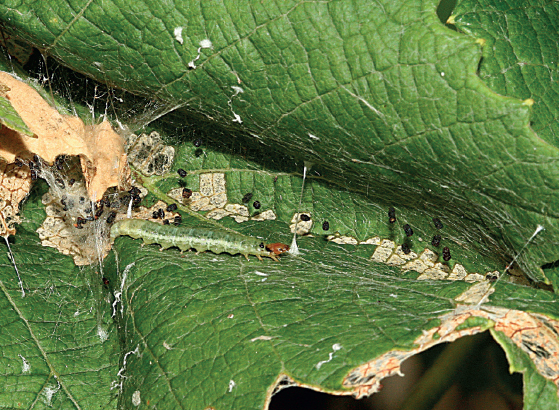
G. Grape leaffolder. DAVID SHETLAR
Skippers are a family (Hesperiidae) within the order Lepidoptera that have adults that fly during the day. Most closely related to the other day-flying Lepidoptera, the butterflies (Papilionidae, Pieridae, Nymphalidae, Lycaenidae), adult skippers can be differentiated by having a relatively stout body, with wings proportionately smaller than butterflies, and antennae that terminate in a hook (rather than a club). Larvae of skippers are marked by having a large round head, and pupal stages are usually covered with a loose cocoon of silk. Approximately 275 species occur in North America, the great majority of which develop feeding on grasses.
SILVERSPOTTED SKIPPER (Epargyreus clarus)1 is the most commonly encountered skipper, found throughout most of the southern border provinces of Canada and most of the continental U.S. except the Great Basin and west Texas. Adults are light brown, heavy-bodied butterflies with a wingspan ranging from 1¾ to 2⅝ inches. The overall color of the wings is brown with a yellow-brown band, but the underside of the lobed hindwing has a metallic silver band.
Larvae develop on wisteria and various leguminous plants such as black locust, honeylocust, false indigo bush, soybean, (Amorpha) and Cassia species. A full-grown larva is about 2 inches long. It has a dark reddish brown head with large yellow eye patches. The prothoracic shield is brown and the abdomen is yellow with darker transverse stripes and spots.
During egg laying, females alight on potential host plants to attach single eggs to leaves. The eggs are green with a red top. After hatching, the young larvae make shelters on the apical halves of leaves by cutting a flap on the leaf margin, folding it over and attaching it with silk. Larger larvae often silk several leaves together to form shelters. They leave the shelters only to feed or to make larger shelters. When mature, the larvae pupate inside the leaf nest. The pupal stage gives rise to summer adults, but pupae formed in the fall spend the winter in the leaf nests. In the more northern parts of its range, one generation is normal, but three to four generations can occur in southern states.
LARGER CANNA LEAFROLLER (Calpodes ethlius)1 chews the leaves of canna lily in the southern and parts of the eastern U.S. It also characteristically folds leaves, fastening them with silk. Several generations can be completed, with larval development taking about 2 weeks. Pupation occurs on a pad of silk in the folded leaf. Peak injury is usually observed in mid- to late summer.
A. Silverspotted skipper adult. DAVID CAPPAERT, BUGWOOD.ORG

B. Leaf folding produced by silverspotted skipper larva. DAVID SHETLAR

C. Larva of the silverspotted skipper. DAVID SHETLAR

D. Leafrolling produced by larger canna leafroller. DAVID SHETLAR

E. Larva of the larger canna leafroller. DAVID SHETLAR

F. Pupa of the larger canna leafroller. HERBERT A. “JOE” PASE III, TEXAS A&M FOREST SERVICE, BUGWOOD.ORG

G. Adult of the larger canna leafroller. HERBERT A. “JOE” PASE III, TEXAS A&M FOREST SERVICE, BUGWOOD.ORG
Larvae of FIERY SKIPPER (Hylephila phyleus)1 chew blades of various turfgrasses. Bermudagrass is often preferred, but St. Augustinegrass, bentgrass, and some grassy weeds such as crabgrass are also eaten. The insect is very widely distributed across the southern half of the U.S., and there are reports of it occasionally being injurious in California and Hawaii. Larvae have a black head with a distinct constriction just behind it. The body color is pale greenish yellow, but larvae darken with age. They construct a loosely webbed shelter among the base of grass plants from which they emerge to forage on nearby grass blades at night. Adults are orange, yellow, or brown heavy-bodied butterflies with a wingspan of about 1 inch.
A great many other skippers develop on grasses. A few of these will feed on turfgrasses, including PECK’S SKIPPER (Polites peckius) and the EUROPEAN SKIPPER (Thymelicus lineola).1 These grass-feeding skippers can be common insects, with adults often seen visiting garden flowers, but they do not occur in populations large enough to cause significant turf injury.
BEAN LEAFROLLER (Urbanus proteus)1 is a tropical species restricted to the extreme southeastern U.S. Adults are sometimes known as “longtail skippers” because they possess tail-like extensions of the wings. Females lay eggs singly or in small groups. The caterpillars cut a small patch at the leaf edge and fold and fashion it into a shelter. They emerge to feed at night on leaves and may cause extensive defoliation to beans late in the summer. As larvae get older, they construct a series of shelters, in the last stage webbing together two separate leaves. Pupation occurs in these folded leaves. A generation can be completed in about a month, and several generations are produced during the year. Bean leafroller is sensitive to cold temperatures and probably dies back in most years to southern Florida, dispersing northward the following year.
1 Lepidoptera: Hesperiidae

B. Fiery skipper larva. DAVID SHETLAR

C. Peck’s skipper. JIM KALISCH, UNIVERSITY OF NEBRASKA
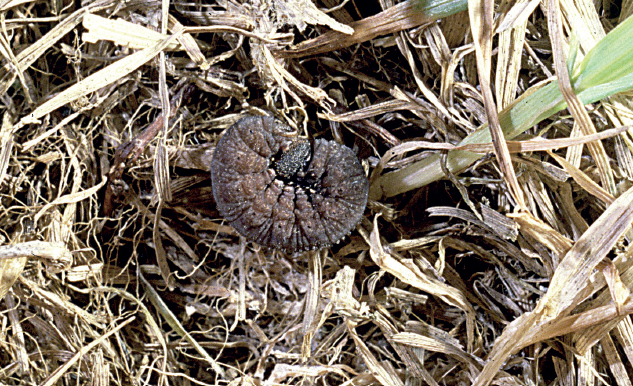
D. Larva of Peck’s skipper in lawn. DAVID SHETLAR

E. Larva of the bean leafroller. RUSS OTTENS, UNIVERSITY OF GEORGIA, BUGWOOD.ORG

F. Adult bean leafroller. JOHN CAPINERA, UNIVERSITY OF FLORIDA